List of Category A listed buildings in Glasgow

This is a list of Category A listed buildings in Glasgow, Scotland.
In Scotland, the term listed building refers to a building or other structure officially designated as being of "special architectural or historic interest".[1] Category A structures are those considered to be "buildings of national or international importance, either architectural or historic, or fine little-altered examples of some particular period, style or building type."[2] Listing was begun by a provision in the Town and Country Planning (Scotland) Act 1947, and the current legislative basis for listing is the Planning (Listed Buildings and Conservation Areas) (Scotland) Act 1997.[3] The authority for listing rests with Historic Scotland, an executive agency of the Scottish Government, which inherited this role from the Scottish Development Department in 1991. Once listed, severe restrictions are imposed on the modifications allowed to a building's structure or its fittings. Listed building consent must be obtained from local authorities prior to any alteration to such a structure.[3] There are approximately 47,400 listed buildings in Scotland, of which around 8% (some 3,800) are Category A.[4]
The medieval city of Glasgow formed around two axes, that of the High Street and the Saltmarket which was bisected by Trongate and Gallowgate at Glasgow Cross. Despite its ancient origins very little of the medieval fabric of the city survives. Only two buildings from the earliest period are extant in Glasgow; the Cathedral and the former canon’s house. Nor do the riggs and wynds of the old city remain, though a great deal of the original street pattern has persisted down the centuries. Additionally, a mere handful of buildings from the period between the Reformation and the end of the eighteenth century have come down to us.[5] The majority of the city’s building stock, then, is nineteenth century when the population of Glasgow rose from c. 78,000 in 1801 to 770,000 in 1901. The pattern of expansion can be traced from the commercial centre of the High Street and Merchant City westwards to the Blythswood Hill New Town laid out in the 1820s and 30s, and south of the river in Laurieston and Tradeston.[6] The feus of both these developments were, unusually for the British Isles, laid out on a gridiron pattern. Further development came with the construction of the Woodlands and Park District areas, the latter of which was the work of Charles Wilson, in the 1830s and 40s. With the relocation of the University from the High street to Gilmorehill in the 1860s came the expansion of the city to the west where suburbs at Dowanhill and Partickhill were laid out on the garden principal with villas and cottages in a number of styles.[7] Similarly, the coming of the railways and trams permitted the development of the suburbs of Pollokshields and Langside to the south. In 1866 the city corporation established the City Improvement Trust to control planning and clear slums. The outlying burghs were amalgamated into the City Corporation in 1891 and in the following decades the city witnessed its peak population of circa 1.1 million. With the post-war period came the proposals of the Bruce Plan in 1945 and the Clyde Valley Report in 1946. The former recommended the phased replacement of the entire city centre and its encirclement with a ring-road, of which scheme only the M8 at Charing Cross and Anderston was completed. The latter advised the displacement of the population of the City centre to New Towns and peripheral estates which led to the contraction of the city’s population and the wholesale redevelopment of areas such as the Gorbals and Townhead.[8]
The architectural character of Glasgow has been described as follows: “[t]he architecture of the City Centre exhibits a distinctive confidence from the late 18th century into the 21st century that makes it unique in Scotland. Although a variety of architectural styles exist, there are certain Glasgow characteristics: depth of modelling; wealth of ornamentation and sculpture; animated roofline; and consistent building lines and predominantly flat (not stepped or curved) linear elevations along the backs of the pavements. Glasgow architects and engineers were, and remain, frequent pioneers of new building technology and materials.”[9] Perhaps the most striking quality of Glasgow’s urban form is the eclectic mix of styles which it exhibits. Of those belonging to the early nineteenth century include: the neoclassicism of William Stark and David Hamilton; a vigorous tradition of Greek Revival, possibly the longest lasting in Britain, which persisted down to the 1890s;[10] Italianate evidenced in the Western Club and Rochead’s 2 St Vincent St.; and Gothic Revival notably practised by Leiper and G. Gilbert Scott. By the mid-century Glasgow had produced its first native architect of national and later international importance in Alexander Thomson, whose eclectic historicism produced its own school. Later nineteenth-century work includes the art nouveau inspired buildings of James Salmon, particularly the “Hatrack” on St Vincent St.; the Beaux arts style common to many public buildings of the period especially the City Chambers; Mackintosh’s art and crafts inflected work; Edwardian Baroque revival; and the distinctive free Glasgow Style of Millar and the later Salmon. The inter-war period sees the use of Art Deco and some reference to the Chicago Style in the elevator buildings demanded by commerce of the time, specifically in James Miller’s St Vincent St. Bank of Scotland and 98 West George Street. Post-war there is the creative application of Functionalism in the work of Jack Coia and Brutalism elsewhere in the city’s redevelopment. The best of Glasgow's historic architecture was metropolitan in its ambition, as the Buildings of Scotland remarks: “A visitor with time to spare will find that the city centre is rich with remarkable buildings from the height of its industrial prosperity and that its grandest suburbs are planned on a scale comparable with many European capitals.”[11]
Listed buildings
[edit]| Name | Location | Date Listed | Grid Ref. [note 1] | Geo-coordinates | Notes | LB Number [note 2] | Image |
|---|---|---|---|---|---|---|---|
| Trinity College | 31, 33, 35 Lynedoch Street and 92, 96 Woodside Terrace Lane | 15 December 1970 | NS5766766228 | 55°52′05″N 4°16′34″W / 55.86814°N 4.276144°W | 1856 architect Charles Wilson. | 32171 | 
|
| Arlington Baths Club | 61 Arlington Street | 20 May 1986 | NS5785566510 | 55°52′15″N 4°16′24″W / 55.870727°N 4.27329°W | 1871 by John Burnet Senior. Additions by A Myles of 1893 and B Conner of 1902. | 32173 | 
|
| 1–12 Claremont Terrace | Claremont Terrace | 15 December 1970 | NS5757166178 | 55°52′04″N 4°16′40″W / 55.867663°N 4.27765°W | John Baird I, architect; 1842-1847. No 6 built first as freestanding mansion in 1842. Remainder of Terrace added in 1847.Includes 1 Claremont Place, and gatepiers to Claremont Terrace Lane | 32185 | ![1–12 Claremont Terrace [de]](http://upload.wikimedia.org/wikipedia/commons/thumb/b/b4/Claremont_Terrace%2C_Glasgow.jpg/150px-Claremont_Terrace%2C_Glasgow.jpg)
|
| Great Western Road Bridge over River Kelvin | West End | 20 May 1986 | NS5746466972 | 55°52′29″N 4°16′47″W / 55.87476°N 4.279776°W | Bell and Miller, engineers; Morrison and Mason, contractors; Sir W Arrol, iron and steel work. Begun April 1890, opened September 1891. | 32197 | 
|
| St Mary's Episcopal Cathedral | 300 Great Western Road/Holyrood Crescent | 15 December 1970 | NS5776066827 | 55°52′25″N 4°16′30″W / 55.873545°N 4.274973°W | George Gilbert Scott, architect, 1871-8. Spire by John Oldrid Scott, completed 1893. | 32198 | 
|
| 445-459 (Odd Nos) Great Western Road and 6 Caledonian Crescent, 1-8 (Inclusive Nos) Caledonian Mansions | 15 December 1970 | NS5738067001 | 55°52′30″N 4°16′52″W / 55.874995°N 4.281133°W | 1897-8 by James Millar. Free Arts and Crafts/ Glasgow Style terrace of tenements. | 32200 | ![445-459 (Odd Nos) Great Western Road [de] and 6 Caledonian Crescent, 1-8 (Inclusive Nos) Caledonian Mansions](http://upload.wikimedia.org/wikipedia/commons/thumb/1/19/445-459_%28Odd_Nos%29_Great_Western_Road_and_6_Caledonian_Crescent%2C_1-8_%28Inclusive_Nos%29_Caledonian_Mansions.jpg/150px-445-459_%28Odd_Nos%29_Great_Western_Road_and_6_Caledonian_Crescent%2C_1-8_%28Inclusive_Nos%29_Caledonian_Mansions.jpg)
| |
| Lansdowne Parish Church (Church of Scotland) | 416 and 420 Great Western Road/433 North Woodside Road | 15 December 1970 | NS5756466941 | 55°52′28″N 4°16′41″W / 55.874511°N 4.278163°W | 1863, John Honeyman. Sculptor; John Mossman. | 32205 | ![Lansdowne Parish Church [de] (Church of Scotland)](http://upload.wikimedia.org/wikipedia/commons/thumb/f/f1/Lansdowne_Parish_Church_Glasgow.jpg/112px-Lansdowne_Parish_Church_Glasgow.jpg)
|
| Roberts Memorial | Kelvingrove Park | 15 December 1970 | NS5731766480 | 55°52′13″N 4°16′55″W / 55.870299°N 4.281865°W | Unveiled in 1916; replica of monument by Harry Bates ARA in Calcutta to Field Marshal Earl Roberts, erected in 1915. | 32211 | ![Roberts Memorial [de]](http://upload.wikimedia.org/wikipedia/commons/thumb/e/e0/Glasgow_-_Lord_Roberts_memorial.jpg/150px-Glasgow_-_Lord_Roberts_memorial.jpg)
|
| Stewart Memorial Fountain | Kelvingrove Park | 15 December 1970 | NS5718466234 | 55°52′05″N 4°17′02″W / 55.868051°N 4.283858°W | 1872 James Sellars, architect; John Mossman, sculptor; H Pringle & Co bronze founders. | 32213 | ![Stewart Memorial Fountain [de]](http://upload.wikimedia.org/wikipedia/commons/thumb/0/03/Stewart_Memorial_Fountain.jpg/112px-Stewart_Memorial_Fountain.jpg)
|
| 41-53 (Odd Nos) Oakfield Avenue and 18 Great George Street | 15 December 1970 | NS5716566914 | 55°52′27″N 4°17′04″W / 55.87415°N 4.28452°W | 1865 by Alexander Thomson. | 32235 | ![41-53 (Odd Nos) Oakfield Avenue [de] and 18 Great George Street](http://upload.wikimedia.org/wikipedia/commons/thumb/7/70/41-53_%28Odd_Nos%29_Oakfield_Avenue_and_18_Great_George_Street.jpg/150px-41-53_%28Odd_Nos%29_Oakfield_Avenue_and_18_Great_George_Street.jpg)
| |
| 1-29 (Inclusive Nos) Park Circus and 9 Park Street South | Park District | 15 December 1970 | NS5754666408 | 55°52′11″N 4°16′41″W / 55.86972°N 4.27817°W | 1855-6 by Charles Wilson. Nos 1-16 built 1857-9; Nos 18-22 built 1861-3 (No 22 by J Boucher 1872); Nos 23-29 built 1872-3. Includes 22 Park Circus, Glasgow | 32238 | 
|
| 1-17 (Odd Nos) and 2-8 (Even Nos) Park Circus Place | Park District | 15 December 1970 | NS5756466296 | 55°52′07″N 4°16′40″W / 55.86872°N 4.277824°W | Charles Wilson, architect: designed 1855-6 built 1872-3. | 32239 | ![1-17 (Odd Nos) and 2-8 (Even Nos) Park Circus Place [de]](http://upload.wikimedia.org/wikipedia/commons/thumb/f/fb/Glasgow_-_Park_Circus_Place.jpg/100px-Glasgow_-_Park_Circus_Place.jpg)
|
| 1-6 (Inclusive Nos) Park Gardens and Park Gardens Lane | Park District | 15 December 1970 | NS5741666220 | 55°52′05″N 4°16′49″W / 55.867994°N 4.280147°W | Charles Wilson, architect; circa 1855. | 32240 | ![1-6 (Inclusive Nos) Park Gardens and Park Gardens Lane [de]](http://upload.wikimedia.org/wikipedia/commons/thumb/7/7b/1-6_%28Inclusive_Nos%29_Park_Gardens_and_Park_Gardens_Lane%2C_Glasgow%2C_2018-06-27.jpg/150px-1-6_%28Inclusive_Nos%29_Park_Gardens_and_Park_Gardens_Lane%2C_Glasgow%2C_2018-06-27.jpg)
|
| Park Gardens, Stairway to Park Street South | Park District | 15 December 1970 | NS5740766239 | 55°52′05″N 4°16′49″W / 55.868162°N 4.280301°W | 1853-4, Charles Wilson. | 32241 | ![Park Gardens, Stairway to Park Street South [de]](http://upload.wikimedia.org/wikipedia/commons/thumb/5/56/Park_Gardens%2C_Stairway_to_Park_Street_South%2C_2018-06-27.jpg/150px-Park_Gardens%2C_Stairway_to_Park_Street_South%2C_2018-06-27.jpg)
|
| 1-5 (Odd Nos Inclusive) and 4 Park Gate | Park District | 15 December 1970 | NS5741566393 | 55°52′10″N 4°16′49″W / 55.869547°N 4.280254°W | 1857-9, Charles Wilson. | 32242 | ![1-5 (Odd Nos Inclusive) and 4 Park Gate [de]](http://upload.wikimedia.org/wikipedia/commons/thumb/3/33/Park_Gate_-_geograph.org.uk_-_768921.jpg/150px-Park_Gate_-_geograph.org.uk_-_768921.jpg)
|
| 1-10 (Inclusive Nos) Park Quadrant | Park District | 15 December 1970 | NS5746466489 | 55°52′14″N 4°16′46″W / 55.870423°N 4.279522°W | Charles Wilson, architect; circa 1855-8. | 32243 | ![1-10 (Inclusive Nos) Park Quadrant [de]](http://upload.wikimedia.org/wikipedia/commons/thumb/0/0b/Glasgow_-_Park_Quadrant.jpg/100px-Glasgow_-_Park_Quadrant.jpg)
|
| 1-21 (Inclusive Nos) Park Terrace and 18-24 (Inclusive Nos) Woodlands Terrace and 2-4 (Even Nos) Park Terrace East Lane and 3 Park Street South | Park District | 15 December 1970 | NS5746066293 | 55°52′07″N 4°16′46″W / 55.868663°N 4.279483°W | Charles Wilson, 1855. | 32245 | ![1-21 (Inclusive Nos) Park Terrace [de] and 18-24 (Inclusive Nos) Woodlands Terrace and 2-4 (Even Nos) Park Terrace East Lane and 3 Park Street South](http://upload.wikimedia.org/wikipedia/commons/thumb/9/9c/Park_Terrace_-_geograph.org.uk_-_768917.jpg/150px-Park_Terrace_-_geograph.org.uk_-_768917.jpg)
|
| Park Terrace Balustrade Railings and Gateway | Kelvingrove Park | 15 December 1970 | NS5735566447 | 55°52′12″N 4°16′52″W / 55.870014°N 4.28124°W | Charles Wilson, architect, circa 1855. | 32246 | ![Park Terrace Balustrade Railings and Gateway [de]](http://upload.wikimedia.org/wikipedia/commons/thumb/9/92/Park_Terrace_Balustrade_Railings_and_Gateway.jpg/150px-Park_Terrace_Balustrade_Railings_and_Gateway.jpg)
|
| Stairway to Clifton Street | Woodlands Terrace | 15 December 1970 | NS5748166227 | 55°52′05″N 4°16′45″W / 55.868076°N 4.279113°W | Circa 1855. | 32267 | ![Stairway to Clifton Street [de]](http://upload.wikimedia.org/wikipedia/commons/thumb/c/c1/Glasgow_-_Stairway_to_Clifton_Street.jpg/150px-Glasgow_-_Stairway_to_Clifton_Street.jpg)
|
| 6-19 (Inclusive No) Woodside Crescent | 15 December 1970 | NS5792766149 | 55°52′03″N 4°16′19″W / 55.867508°N 4.271951°W | 1831, George Smith. | 32268 | ![6-19 (Inclusive No) Woodside Crescent [de]](http://upload.wikimedia.org/wikipedia/commons/thumb/8/89/6-19_%28Inclusive_No%29_Woodside_Crescent.jpg/150px-6-19_%28Inclusive_No%29_Woodside_Crescent.jpg)
| |
| 1-28 (Inclusive Nos) Woodside Place and 138, 140 Elderslie Street | 15 December 1970 | NS5786166098 | 55°52′01″N 4°16′23″W / 55.86703°N 4.272978°W | 1838, George Smith. | 32270 | ![1-28 (Inclusive Nos) Woodside Place [de] and 138, 140 Elderslie Street](http://upload.wikimedia.org/wikipedia/commons/thumb/3/3a/1-28_%28Inclusive_Nos%29_Woodside_Place_and_138%2C_140_Elderslie_Street.jpg/150px-1-28_%28Inclusive_Nos%29_Woodside_Place_and_138%2C_140_Elderslie_Street.jpg)
| |
| 1-22 (Inclusive Nos) Woodside Terrace, 11-63 Woodside Terrace Lane, 4 Claremount Place | 15 December 1970 | NS5774066180 | 55°52′04″N 4°16′30″W / 55.867731°N 4.274953°W | George Smith, architect. Nos 1-11, 1835; Nos 12-21, 1842. | 32271 | ![1-22 (Inclusive Nos) Woodside Terrace [de], 11-63 Woodside Terrace Lane, 4 Claremount Place](http://upload.wikimedia.org/wikipedia/commons/thumb/f/f5/Glasgow%2C_Woodside_Terrace_-_geograph.org.uk_-_1539316.jpg/150px-Glasgow%2C_Woodside_Terrace_-_geograph.org.uk_-_1539316.jpg)
| |
| North British Engine Works | 739 South Street | 22 August 1984 | NS5341566914 | 55°52′23″N 4°20′40″W / 55.873024°N 4.344401°W | J Galt architect, 1913-14. Steel framed, brick and glass building modelled on Peter Behren's A E G Turbine Factory in Berlin (1909). | 32280 | 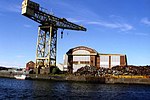
|
| Former North British Diesel Engine Engine Works, Quayside Titan Crane | 739 South Street | 14 April 1989 | NS5334166844 | 55°52′21″N 4°20′44″W / 55.872373°N 4.345545°W | Ordered 1913, completed 1920; by Sir William Arrol and Co Ltd. | 32281 | 
|
| 48 Cleveden Drive, Stoneleigh, and Gatepiers | 15 December 1970 | NS5597668019 | 55°53′01″N 4°18′15″W / 55.883717°N 4.304095°W | H E Clifford, built circa 1900-10. | 32306 | ![48 Cleveden Drive, Stoneleigh [de], and Gatepiers](http://upload.wikimedia.org/wikipedia/commons/thumb/8/80/48_Cleveden_Drive%2C_Stoneleigh%2C_and_Gatepiers-2.jpg/150px-48_Cleveden_Drive%2C_Stoneleigh%2C_and_Gatepiers-2.jpg)
| |
| Forth and Clyde Canal Aqueduct | Adjoining Skaethorn Road Bridge | 10 July 1989 | NS5615268980 | 55°53′33″N 4°18′06″W / 55.892397°N 4.301795°W | Robert Whitworth, engineer, 1787-90. | 32316 | 
|
| Gartnavel Royal Hospital | 1055 Great Western Road | 15 December 1970 | NS5503068034 | 55°53′01″N 4°19′09″W / 55.883567°N 4.319213°W | 1841-3, Charles Wilson. | 32318 | 
|
| St Mungo’s Academy Centenary Club | 998 Great Western Road | 15 December 1970 | NS5593868004 | 55°53′01″N 4°18′17″W / 55.883571°N 4.304694°W | 1877, James Boucher. | 32334 | ![St Mungo’s Academy Centenary Club [de]](http://upload.wikimedia.org/wikipedia/commons/thumb/b/bf/St_Mungos_Academy_Centenary_Club.jpg/150px-St_Mungos_Academy_Centenary_Club.jpg)
|
| 11 Whittinghame Drive | 5 September 1979 | NS5529068166 | 55°53′05″N 4°18′54″W / 55.884831°N 4.315131°W | John Ednie, 1907. | 32342 | ![11 Whittinghame Drive [de]](http://upload.wikimedia.org/wikipedia/commons/thumb/4/4b/11_Whittinghame_Drive.jpg/150px-11_Whittinghame_Drive.jpg)
| |
| Ruchill Church Hall | 17 Shakespeare Street | 15 December 1970 | NS5725668308 | 55°53′12″N 4°17′02″W / 55.886692°N 4.283802°W | Charles Rennie Mackintosh, 1899. | 32356 | 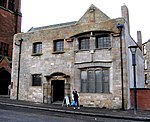
|
| Queen's Park Church and Hall | 20 Balvicar Drive, Balvicar Street, Camphill | 15 December 1970 | NS5786562432 | 55°50′03″N 4°16′16″W / 55.834119°N 4.270993°W | William Leiper, 1875-8. | 32359 | ![Queen's Park Church and Hall [de]](http://upload.wikimedia.org/wikipedia/commons/thumb/f/ff/Queen%27s_Park_Baptist_Church%2C_Glasgow%2C_Scotland.jpg/71px-Queen%27s_Park_Baptist_Church%2C_Glasgow%2C_Scotland.jpg)
|
| Langside Hall | 1 Langside Avenue | 15 December 1970 | NS5744562150 | 55°49′53″N 4°16′39″W / 55.831463°N 4.277545°W | John Gibson (of Gibson and MacDougall) 1847-9 as National Bank of Scotland, Queen Street; re-erected without significant change on this site 1901; A B MacDonald City Engineer, assistant in charge named Horne. | 32369 | ![Langside Hall [de]](http://upload.wikimedia.org/wikipedia/commons/thumb/0/0c/Langside_Hall%2C_Glasgow_-_geograph.org.uk_-_92256.jpg/150px-Langside_Hall%2C_Glasgow_-_geograph.org.uk_-_92256.jpg)
|
| 25, 25A Mansionhouse Road | 15 December 1970 | NS5759161495 | 55°49′32″N 4°16′30″W / 55.825626°N 4.274872°W | Alexander Thomson, 1856-7. | 32373 | ![25, 25A Mansionhouse Road [de]](http://upload.wikimedia.org/wikipedia/commons/thumb/b/b9/25_Mansionhouse_Road%2C_Glasgow%2C_Scotland.jpg/150px-25_Mansionhouse_Road%2C_Glasgow%2C_Scotland.jpg)
| |
| 2, 2A-38 (Even Nos) Millbrae Crescent | 15 December 1970 | NS5752161115 | 55°49′20″N 4°16′33″W / 55.822194°N 4.27579°W | 1876-7 in style of Robert Turnbull. | 32384 | 
| |
| 1-10 (Inclusive Nos) Moray Place Including 81 Nithsdale Road | 6 July 1966 | NS5771962789 | 55°50′14″N 4°16′25″W / 55.837281°N 4.273509°W | Built 1859-60, design perhaps 1857, by Alexander Thomson. Thomson himself resided at No 1. | 32386 | ![1-10 (Inclusive Nos) Moray Place [de] Including 81 Nithsdale Road](http://upload.wikimedia.org/wikipedia/commons/thumb/1/15/Moray_Place_Glasgow.jpg/150px-Moray_Place_Glasgow.jpg)
| |
| Camphill House | 799 Pollokshaws Road | 15 December 1970 | NS5759762225 | 55°49′56″N 4°16′31″W / 55.832181°N 4.27516°W | Possibly David Hamilton as architect. Built for Robert Thomson, cotton manufacturer, probably circa 1798. | 32401 | ![Camphill House [de]](http://upload.wikimedia.org/wikipedia/commons/thumb/2/22/799_Pollokshaws_Road%2C_Queen%27s_Park%2C_Camphill_House_01.jpg/150px-799_Pollokshaws_Road%2C_Queen%27s_Park%2C_Camphill_House_01.jpg)
|
| 265-289 (Odd Nos) Allison Street, 19, 21, 23 Garturk Street and 34 Daisy Street | 15 December 1970 | NS5863262593 | 55°50′09″N 4°15′32″W / 55.83579°N 4.258841°W | Alexander Thomson (d 1875), 1875-7, and presumably completed by his partner, Robert Turnbull, in Thomson's own style. | 32423 | ![265-289 (Odd Nos) Allison Street [de], 19, 21, 23 Garturk Street and 34 Daisy Street](http://upload.wikimedia.org/wikipedia/commons/thumb/6/65/265-289_Allison_Street%2C_Glasgow%2C_Scotland.jpg/150px-265-289_Allison_Street%2C_Glasgow%2C_Scotland.jpg)
| |
| Former Crosshill Queen's Park Church | 40 Queen's Drive | 15 December 1970 | NS5846562186 | 55°49′56″N 4°15′41″W / 55.832087°N 4.261293°W | Campbell Douglas and Sellars, 1872-3. | 32451 | 
|
| Kelvinside Academy | 20 Bellshaugh Road | 6 July 1966 | NS5655667906 | 55°52′58″N 4°17′41″W / 55.882875°N 4.294771°W | James Sellars, architect; 1877-9. | 32476 | 
|
| 15 Cleveden Gardens | 15 December 1970 | NS5625768120 | 55°53′05″N 4°17′59″W / 55.884707°N 4.29966°W | 1904, A N Prentice. | 32486 | ![15 Cleveden Gardens [de]](http://upload.wikimedia.org/wikipedia/commons/thumb/f/f9/15_Cleveden_Gardens.jpg/150px-15_Cleveden_Gardens.jpg)
| |
| 3-10 (Inclusive Nos) Crown Circus and 1, 1A and 2 Crown Terrace and 15 and 17 Crown Road North | 15 December 1970 | NS5616067157 | 55°52′34″N 4°18′03″W / 55.876033°N 4.300698°W | James Thompson, 1858. | 32489 | ![3-10 (Inclusive Nos) Crown Circus [de] and 1, 1A and 2 Crown Terrace and 15 and 17 Crown Road North](http://upload.wikimedia.org/wikipedia/commons/thumb/f/fc/Crown_Crescent%2C_Glasgow.jpg/150px-Crown_Crescent%2C_Glasgow.jpg)
| |
| Kibble Palace | Botanic Gardens, 730 Great Western Road | 15 December 1970 | NS5693867446 | 55°52′44″N 4°17′18″W / 55.878859°N 4.288426°W | John Kibble, engineer. Originally erected 1863-6 at Coulport, Loch Long; removed here and enlarged 1873. | 32513 | 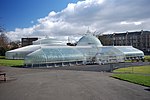
|
| 1-11 (Inclusive Nos) Great Western Terrace, 2-34 (Even Nos) Great Western Terrace Lane, 1 and 1B Westbourne Gardens and 19 Westbourne Gardens | Great Western Road | 15 December 1970 | NS5621067704 | 55°52′51″N 4°18′01″W / 55.880959°N 4.30019°W | 1869, Alexander Thomson. | 32517 | ![1-11 (Inclusive Nos) Great Western Terrace [de], 2-34 (Even Nos) Great Western Terrace Lane, 1 and 1B Westbourne Gardens and 19 Westbourne Gardens](http://upload.wikimedia.org/wikipedia/commons/thumb/e/e8/2-10_Great_Western_Terrace_-_general_view.jpg/100px-2-10_Great_Western_Terrace_-_general_view.jpg)
|
| 1-17 (Inclusive Nos) Grosvenor Terrace | Great Western Road | 6 July 1966 | NS5670967376 | 55°52′41″N 4°17′31″W / 55.878163°N 4.292047°W | J T Rochead, 1855. Eastern half of terrace gutted by fire in 1978, rebuilt 1980. | 32520 | ![1-17 (Inclusive Nos) Grosvenor Terrace [de]](http://upload.wikimedia.org/wikipedia/commons/thumb/6/6e/1-17_%28Inclusive_Nos%29_Grosvenor_Terrace.jpg/150px-1-17_%28Inclusive_Nos%29_Grosvenor_Terrace.jpg)
|
| 21-39 (Odd Nos) Hyndland Road | 6 July 1966 | NS5599367796 | 55°52′54″N 4°18′13″W / 55.88172°N 4.303705°W | 1871, Alexander Thomson. | 32530 | ![21-39 (Odd Nos) Hyndland Road [de]](http://upload.wikimedia.org/wikipedia/commons/thumb/7/7b/21-39_%28Odd_Nos%29_Hyndland_Road.jpg/150px-21-39_%28Odd_Nos%29_Hyndland_Road.jpg)
| |
| Hyndland Parish Church, Church of Scotland | 79 Hyndland Road | 15 December 1970 | NS5588167507 | 55°52′45″N 4°18′19″W / 55.879092°N 4.30534°W | William Leiper, 1886. | 32532 | 
|
| 3 Kirklee Road and 1 Redlands Road | 15 December 1970 | NS5639767727 | 55°52′52″N 4°17′50″W / 55.881221°N 4.297216°W | John A Campbell, circa 1902. | 32550 | ![3 Kirklee Road [de] and 1 Redlands Road](http://upload.wikimedia.org/wikipedia/commons/thumb/7/74/3_Kirklee_Road_and_1_Redlands_Road.jpg/150px-3_Kirklee_Road_and_1_Redlands_Road.jpg)
| |
| 7-23 (Odd Nos) Kirklee Road and 2 Redlands Road | 15 December 1970 | NS5644067786 | 55°52′54″N 4°17′48″W / 55.881763°N 4.29656°W | John A Campbell, 1900. | 32551 | ![7-23 (Odd Nos) Kirklee Road [de] and 2 Redlands Road](http://upload.wikimedia.org/wikipedia/commons/thumb/4/49/7-23_%28Odd_Nos%29_Kirklee_Road_and_2_Redlands_Road.jpg/150px-7-23_%28Odd_Nos%29_Kirklee_Road_and_2_Redlands_Road.jpg)
| |
| 1-14 (Inclusive Nos) Kirklee Terrace, and 1-14 Kirklee Terrace Lane (Inclusive Numbers) | Great Western Road | 6 July 1966 | NS5657567630 | 55°52′49″N 4°17′40″W / 55.880403°N 4.294321°W | 1845, Charles Wilson. | 32553 | ![1-14 (Inclusive Nos) Kirklee Terrace [de], and 1-14 Kirklee Terrace Lane (Inclusive Numbers)](http://upload.wikimedia.org/wikipedia/commons/thumb/8/81/1-14_%28Inclusive_Nos%29_Kirklee_Terrace.jpg/150px-1-14_%28Inclusive_Nos%29_Kirklee_Terrace.jpg)
|
| 9 Lowther Terrace | Great Western Road | 15 December 1970 | NS5630067744 | 55°52′53″N 4°17′56″W / 55.881345°N 4.298774°W | Sydney Mitchell, 1904-6. | 32563 | ![9 Lowther Terrace [de]](http://upload.wikimedia.org/wikipedia/commons/thumb/4/43/9_Lowther_Terrace-2.jpg/112px-9_Lowther_Terrace-2.jpg)
|
| 10 Lowther Terrace | Great Western Road | 15 December 1970 | NS5628867750 | 55°52′53″N 4°17′56″W / 55.881395°N 4.298969°W | James Miller, 1904. | 32564 | ![10 Lowther Terrace [de]](http://upload.wikimedia.org/wikipedia/commons/thumb/f/fa/10_Lowther_Terrace.jpg/112px-10_Lowther_Terrace.jpg)
|
| Notre Dame High School | 160 Observatory Road | 28 July 1987 | NS5626667407 | 55°52′42″N 4°17′57″W / 55.878309°N 4.299138°W | Thomas S Cordiner, designed 1939, resumed 1949 completed 1953. Damaged by fire, 2010 | 32571 | 
|
| 1 Princes Terrace | Prince Albert Road | 15 December 1970 | NS5616267256 | 55°52′37″N 4°18′03″W / 55.876922°N 4.300719°W | James Thomson, circa 1870. | 32576 | ![1 Princes Terrace [de]](http://upload.wikimedia.org/wikipedia/commons/thumb/7/7f/1_Princes_Terrace%2C_Glasgow.jpg/150px-1_Princes_Terrace%2C_Glasgow.jpg)
|
| Kelvinside Hillhead Parish Church, Glasgow | 23 Saltoun Street | 15 December 1970 | NS5662967303 | 55°52′39″N 4°17′36″W / 55.877483°N 4.293286°W | James Sellars, 1875-6.Church of Scotland. Formerly Belmont and Hillhead Parish Church. | 32584 | 
|
| Belhaven-Westbourne Church and Hall, Church of Scotland | 52 Westbourne Gardens | 15 December 1970 | NS5602167768 | 55°52′53″N 4°18′12″W / 55.881477°N 4.303243°W | 1881, John Honeyman. | 32605 | ![Belhaven-Westbourne Church [de] and Hall, Church of Scotland](http://upload.wikimedia.org/wikipedia/commons/thumb/4/4a/Belhaven-Westbourne_Church_and_Hall%2C_Church_of_Scotland.jpg/150px-Belhaven-Westbourne_Church_and_Hall%2C_Church_of_Scotland.jpg)
|
| 145-195 (Odd Nos) Albion Street | 3 September 1974 | NS5965565265 | 55°51′36″N 4°14′38″W / 55.860078°N 4.243903°W | Sir Owen Williams, 1936; 1986 alterations and large additions. Roof top addition by Frank Burnet, Bell and Partners, 1986-1988. | 32607 | ![145-195 (Odd Nos) Albion Street [de]](http://upload.wikimedia.org/wikipedia/commons/thumb/5/5d/The_Herald_Building%2C_145-195_%28Odd_Nos%29_Albion_Street%2C_Glasgow%2C_2018-06-28_angle.jpg/150px-The_Herald_Building%2C_145-195_%28Odd_Nos%29_Albion_Street%2C_Glasgow%2C_2018-06-28_angle.jpg)
| |
| Buck's Head Buildings | 63 Argyle Street | 15 December 1970 | NS5918565002 | 55°51′27″N 4°15′05″W / 55.857579°N 4.251269°W | Alexander Thomson, 1863. | 32608 | ![Buck's Head Buildings [de]](http://upload.wikimedia.org/wikipedia/commons/thumb/5/50/Bucks_Head_Buildings_%28geograph_2746497%29.jpg/112px-Bucks_Head_Buildings_%28geograph_2746497%29.jpg)
|
| Argyle Street, Argyll Arcade (Through 98-102 Argyle Street) 3-66 (Inclusive Nos, Leading to Buchanan Street) | Argyle Street | 15 December 1970 | NS5906065089 | 55°51′30″N 4°15′12″W / 55.858324°N 4.25331°W | John Baird I, 1827. | 32613 | ![Argyle Street, Argyll Arcade [de] (Through 98-102 Argyle Street) 3-66 (Inclusive Nos, Leading to Buchanan Street)](http://upload.wikimedia.org/wikipedia/commons/thumb/a/a1/Argyle_Arcade_-_geograph.org.uk_-_110486.jpg/150px-Argyle_Arcade_-_geograph.org.uk_-_110486.jpg)
|
| David Sloan's Arcade Cafe | 62 Argyll Arcade/108 Argyle Street, Morrison Court | 15 December 1970 | NS5903665113 | 55°51′31″N 4°15′13″W / 55.858532°N 4.253705°W | Possibly by John Baird 1827-8; interior remodelled by Charles H Robinson 1900. | 32614 | 
|
| Martyrs' Public School | 17 Parson Street. | 15 December 1970 | NS6008165839 | 55°51′55″N 4°14′15″W / 55.865355°N 4.237399°W | Charles Rennie Mackintosh (of John Honeyman and Keppie), 1895-1898. | 32619 | 
|
| 60-62 (Even Nos) Buchanan Street | Buchanan Street | 15 December 1970 | NS5901965226 | 55°51′34″N 4°15′15″W / 55.859542°N 4.254035°W | Robert Thomson (with Andrew Wilson assisting), 1894-96. | 32635 | ![60-62 (Even Nos) Buchanan Street [de]](http://upload.wikimedia.org/wikipedia/commons/thumb/f/f0/60-62_Buchanan_Street%2C_Glasgow.jpg/84px-60-62_Buchanan_Street%2C_Glasgow.jpg)
|
| 92-100 (Even Nos) Buchanan Street, known as 98 Buchanan Street | Buchanan Street | 15 December 1970 | NS5903365310 | 55°51′37″N 4°15′14″W / 55.8603°N 4.253856°W | Charles Wilson, 1850-51. | 32639 | ![92-100 (Even Nos) Buchanan Street [de], known as 98 Buchanan Street](http://upload.wikimedia.org/wikipedia/commons/thumb/9/97/98_Buchanan_Street%2C_Glasgow.jpg/150px-98_Buchanan_Street%2C_Glasgow.jpg)
|
| Britannia Buildings | 164A-168 (Even Nos) Buchanan Street with 10 Dundas Lane | 15 December 1970 | NS5909765542 | 55°51′45″N 4°15′11″W / 55.862402°N 4.252954°W | John A Campbell, 1898. | 32643 | ![Britannia Buildings [de]](http://upload.wikimedia.org/wikipedia/commons/thumb/e/e9/Britannia_Buildings.jpg/112px-Britannia_Buildings.jpg)
|
| Glasgow City Halls | Candleriggs, Merchant City | 15 December 1970 | NS5957165145 | 55°51′32″N 4°14′43″W / 55.858976°N 4.245182°W | Main hall facade to Candleriggs John Carrick, 1885. Complex site with multiple architects over time.[12] | 32647 | 
|
| Provand's Lordship | 3 Castle Street | 6 July 1966 | NS6009665506 | 55°51′45″N 4°14′13″W / 55.86237°N 4.236987°W | 1471 with extensions to the West of 1670. | 32648 | 
|
| Bridge of Sighs and Superintendent's House | Cathedral Square | 15 December 1970 | NS6018265506 | 55°51′45″N 4°14′08″W / 55.862395°N 4.235614°W | David and James Hamilton architects, 1833-40. Includes gates and gatepiers by David Hamilton, 1838, ironwork of gates by T Edington. | 32651 | ![Bridge of Sighs and Superintendent's House [de]](http://upload.wikimedia.org/wikipedia/commons/thumb/2/2a/Glasgow_Necropolis_003.jpg/150px-Glasgow_Necropolis_003.jpg)
|
| Glasgow Evangelical Church; (Former Barony North Church), and Church House | 20 Cathedral Square, 14 Cathedral Square | 15 December 1970 | NS6021265399 | 55°51′41″N 4°14′06″W / 55.861443°N 4.23508°W | John Honeyman, 1878. | 32652 | ![Glasgow Evangelical Church [de]; (Former Barony North Church), and Church House](http://upload.wikimedia.org/wikipedia/commons/thumb/8/87/Glasgow%2C_Glasgow_Evangelical_Church_-_geograph.org.uk_-_1535218.jpg/112px-Glasgow%2C_Glasgow_Evangelical_Church_-_geograph.org.uk_-_1535218.jpg)
|
| Glasgow Cathedral and Cathedral Graveyard | 70 Cathedral Square | 15 December 1970 | NS6025565657 | 55°51′50″N 4°14′04″W / 55.863771°N 4.234527°W | A new cathedral to serve the diocese of Glasgow was begun circa 1118 and consecrated in 1136. Further works in the 1180s prior to its second consecration in 1197. Subsequent campaigns of work include the Blackadder aisle completed between 1483 and 1508.[13] | 32654 | 
|
| Statue of William III | Cathedral Square | 6 July 1966 | NS6013565441 | 55°51′42″N 4°14′11″W / 55.861797°N 4.236331°W | Presented 1835 by Governor Macrae of Madras. Equestrian bronze of William III (as Emperor Constantine), sculptor unknown. | 32660 | 
|
| Former Our Lady and St Francis Secondary School | 72 Charlotte Street | 4 September 1989 | NS5979364539 | 55°51′13″N 4°14′29″W / 55.8536°N 4.241324°W | Jack Coia of Gillespie, Kidd & Coia, 1963. | 32662 | ![Former Our Lady and St Francis Secondary School [de]](http://upload.wikimedia.org/wikipedia/commons/thumb/0/0a/Former_Our_Lady_%26_St_Francis_Secondary_School_%28geograph_4254514%29.jpg/150px-Former_Our_Lady_%26_St_Francis_Secondary_School_%28geograph_4254514%29.jpg)
|
| 52 Charlotte Street | 15 December 1970 | NS5983264628 | 55°51′16″N 4°14′27″W / 55.85441°N 4.240748°W | Built circa 1790, school of Robert Adam. | 32663 | ![52 Charlotte Street [de]](http://upload.wikimedia.org/wikipedia/commons/thumb/a/a3/52_Charlotte_Street%2C_Glasgow._2018-06-27.jpg/150px-52_Charlotte_Street%2C_Glasgow._2018-06-27.jpg)
| |
| Old Fish Market known as the Briggait | 72 Clyde Street and 135 Bridgegate | 15 October 1970 | NS5928264640 | 55°51′16″N 4°14′58″W / 55.854358°N 4.249533°W | Clarke and Bell, 1873. | 32664 | 
|
| Merchants Steeple, now enclosed within The Briggait | 72 Clyde Street, Bridgegate | 6 July 1966 | NS5930564671 | 55°51′17″N 4°14′57″W / 55.854643°N 4.249182°W | Completed 1665. | 32665 | 
|
| St Andrew's Roman Catholic Cathedral | 168 Clyde Street and Fox Lane | 15 December 1970 | NS5908064792 | 55°51′20″N 4°15′10″W / 55.855663°N 4.252836°W | J Gillespie Graham, 1814-17. | 32666 | 
|
| Albert Bridge | Clyde Street | 22 March 1977 | NS5941264443 | 55°51′09″N 4°14′50″W / 55.852627°N 4.247356°W | Bell and Miller, architects and engineers, Hanna, Donald and Wilson contractors; 1868-1871. | 32667 | 
|
| South Portland Street Suspension Bridge | Clyde Street and South Portland Street | 6 July 1966 | NS5890764722 | 55°51′18″N 4°15′20″W / 55.854984°N 4.255561°W | Alexander Kirkland, architect. George Martin, engineer. 1851-3. | 32668 | 
|
| Victoria Bridge | Clyde Street | 15 December 1970 | NS5917364578 | 55°51′14″N 4°15′04″W / 55.853769°N 4.25124°W | James Walker, engineer; 1851-1854. | 32669 | 
|
| Formerly the John Street Church | 29 Cochrane Street and 18 John Street | 15 December 1970 | NS5943665275 | 55°51′36″N 4°14′51″W / 55.860104°N 4.247404°W | J T Rochead, 1859. | 32672 | ![Formerly the John Street Church [de]](http://upload.wikimedia.org/wikipedia/commons/thumb/b/b4/29_Cochrane_Street_and_18_John_Street_formerly_the_John_Street_Church%2C_2018-06-30_60deg.jpg/150px-29_Cochrane_Street_and_18_John_Street_formerly_the_John_Street_Church%2C_2018-06-30_60deg.jpg)
|
| Extension to the City Chambers | 20-40 (Even Nos) Cochrane Street, 20 John Street and 233-235 (Odd Nos) George Street | 15 December 1970 | NS5943465380 | 55°51′40″N 4°14′51″W / 55.861046°N 4.24749°W | Watson Salmond and Gray, 1913-1929. | 32675 | 
|
| Former General Post Office | George Square | 15 December 1970 | NS5928265311 | 55°51′37″N 4°15′00″W / 55.860382°N 4.249881°W | Original building Robert Mathieson, architect H M Office of Public Works for Scotland, 1875-8. Rear elevation to Ingram Street remodelled by W W Robertson in 1892-4. Side elevations enclosing Robertson's work, by W T Oldrieve and C J W Simpson, 1914-16. | 32685 | ![Former General Post Office [de]](http://upload.wikimedia.org/wikipedia/commons/thumb/f/fb/Former_General_Post_Office.jpg/150px-Former_General_Post_Office.jpg)
|
| 24 George Square and 12-16 (Even Nos) Anchor Lane | George Square | 15 December 1970 | NS5916465420 | 55°51′41″N 4°15′07″W / 55.861326°N 4.251821°W | James Sellars, 1874. | 32688 | ![24 George Square [de] and 12-16 (Even Nos) Anchor Lane](http://upload.wikimedia.org/wikipedia/commons/thumb/c/c9/24_George_Square%2C_Glasgow%2C_2018-06-27.jpg/110px-24_George_Square%2C_Glasgow%2C_2018-06-27.jpg)
|
| The Merchants' House | 30 George Square and 7 West George Street | 15 December 1970 | NS5916965440 | 55°51′41″N 4°15′06″W / 55.861507°N 4.251752°W | John Burnet, 1874-8, 3-storey and basement office building, raised by J J Burnet 1907-8, by 2 storeys and an attic. Sculpture by Young. | 32689 | ![The Merchants' House [de]](http://upload.wikimedia.org/wikipedia/commons/thumb/b/b7/The_Merchants_House_%28geograph_4685698%29.jpg/122px-The_Merchants_House_%28geograph_4685698%29.jpg)
|
| Glasgow City Chambers | 80 George Square | 15 December 1970 | NS5936065375 | 55°51′40″N 4°14′55″W / 55.860979°N 4.248669°W | William Young, architect, 1882-1888, interior 1887-1890. Contractors, Morrison and Mason. Sculpture by John Mossman and George Lawson. | 32691 | 
|
| Walter Scott Memorial Column | George Square | 6 July 1966 | NS5926665396 | 55°51′40″N 4°15′01″W / 55.86114°N 4.250181°W | Column and base by David Rhind, 1837. Statue designed by John Greenshields, executed by A Handyside Ritchie. | 32696 | ![Walter Scott Memorial Column [de]](http://upload.wikimedia.org/wikipedia/commons/thumb/9/9a/Walter_Scott_statue%2C_Glasgow.JPG/101px-Walter_Scott_statue%2C_Glasgow.JPG)
|
| James Watt Statue | George Square | 6 July 1966 | NS5920065384 | 55°51′40″N 4°15′04″W / 55.861013°N 4.251228°W | Francis Chantrey, 1832. | 32697 | ![James Watt Statue [de]](http://upload.wikimedia.org/wikipedia/commons/thumb/c/c7/James_Watt_George_Square_-_geograph.org.uk_-_1267210.jpg/112px-James_Watt_George_Square_-_geograph.org.uk_-_1267210.jpg)
|
| Sir John Moore Statue | George Square | 6 July 1966 | NS5931565357 | 55°51′39″N 4°14′58″W / 55.860804°N 4.249378°W | John Flaxman, 1819. | 32698 | ![Sir John Moore Statue [de]](http://upload.wikimedia.org/wikipedia/commons/thumb/9/99/JohnMooreGlasgow.jpg/75px-JohnMooreGlasgow.jpg)
|
| Equestrian statue of Albert, Prince Consort (Glasgow) | George Square | 15 December 1970 | NS5920065384 | 55°51′40″N 4°15′04″W / 55.861013°N 4.251228°W | Baron Carlo Marochetti, pre-1854. | 32701 | ![Equestrian statue of Albert, Prince Consort (Glasgow) [de]](http://upload.wikimedia.org/wikipedia/commons/thumb/e/ed/Glasgow_%2815741422759%29.jpg/150px-Glasgow_%2815741422759%29.jpg)
|
| Equestrian statue of Victoria (Glasgow) | George Square | 15 December 1970 | NS5921465439 | 55°51′41″N 4°15′04″W / 55.861511°N 4.251033°W | Baron Carlo Marochetti, pre-1854. | 32702 | ![Equestrian statue of Victoria (Glasgow) [de]](http://upload.wikimedia.org/wikipedia/commons/thumb/d/d6/VictoriaStatue.jpg/150px-VictoriaStatue.jpg)
|
| 266 George Street | 9 March 1989 | NS5940565443 | 55°51′42″N 4°14′53″W / 55.861603°N 4.247986°W | Thomson and Sandilands, 1900. | 32709 | ![266 George Street [de]](http://upload.wikimedia.org/wikipedia/commons/thumb/4/47/266_George_Street%2C_Glasgow%2C_2018-06-27.jpg/106px-266_George_Street%2C_Glasgow%2C_2018-06-27.jpg)
| |
| The Trades Hall of Glasgow | 85 Glassford Street | 6 July 1966 | NS5932965183 | 55°51′33″N 4°14′57″W / 55.859246°N 4.249064°W | Robert Adam, 1791-9, completed posthumously. David Hamilton extensions at rear 1838, interior recast by James Sellars in 1887-8 partially or totally refaced by John Keppie 1927; 1916 John Keppie redecorated the saloon. | 32713 | ![The Trades Hall of Glasgow [de]](http://upload.wikimedia.org/wikipedia/commons/thumb/a/a4/The_Trades_Hall_of_Glasgow.jpg/150px-The_Trades_Hall_of_Glasgow.jpg)
|
| Tolbooth Steeple | Glasgow Cross | 6 July 1966 | NS5965964900 | 55°51′24″N 4°14′37″W / 55.856802°N 4.24365°W | Built 1626-1634 by John Boyd, architect and Master of Works. The Tolbooth was demolished in 1921. | 32717 | 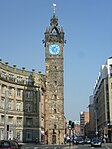
|
| 177 Ingram Street with 99 Glassford Street | 15 December 1970 | NS5933365224 | 55°51′35″N 4°14′56″W / 55.859616°N 4.249022°W | John Burnet, 1865-66. Sculpture by George Frampton. | 32734 | ![177 Ingram Street with 99 Glassford Street [de]](http://upload.wikimedia.org/wikipedia/commons/thumb/7/74/177_Ingram_Street_with_99_Glassford_Street.jpg/150px-177_Ingram_Street_with_99_Glassford_Street.jpg)
| |
| Lanarkshire House, Corinthian Club (Former Sheriff Court and Justice of Peace Court) | 191 Ingram Street | 15 December 1970 | NS5928965217 | 55°51′34″N 4°14′59″W / 55.85954°N 4.249721°W | David Hamilton in 1841 with alterations and additions including a telling room by James Salmon Sr in 1853. It was refronted and additions made by John Burnet Senior in 1876-9.[14] | 32735 | 
|
| Ramshorn Theatre | 98 Ingram Street | 15 December 1970 | NS5958565228 | 55°51′35″N 4°14′42″W / 55.859725°N 4.245001°W | Thomas Rickman, 1824-1826; Page and Park, conversion to theatre c1990-92. Formerly St Paul's and St David's Church, Church of Scotland | 32740 | 
|
| Hutchesons' Hall | 158 Ingram Street, and 2 John Street | 6 November 1966 | NS5942265249 | 55°51′36″N 4°14′51″W / 55.859866°N 4.247614°W | David Hamilton, 1802-1805, interior by John Baird II 1876. | 32744 | 
|
| 16 McPhater Street, and return elevation to Dunblane Street (Ozalid's) | 15 December 1970 | NS5897666080 | 55°52′02″N 4°15′19″W / 55.867196°N 4.255166°W | William James Anderson, 1892-95. | 32754 | ![16 McPhater Street [de], and return elevation to Dunblane Street (Ozalid's)](http://upload.wikimedia.org/wikipedia/commons/thumb/b/bc/McPhater_Street_-_geograph.org.uk_-_995658.jpg/150px-McPhater_Street_-_geograph.org.uk_-_995658.jpg)
| |
| 61-63 (Odd Nos) Miller Street | 15 December 1970 | NS5919065177 | 55°51′33″N 4°15′05″W / 55.859152°N 4.25128°W | J Burnet Sr, 1854 with alterations by J Burnet and Son, 1900 and 1901. | 32758 | ![61-63 (Odd Nos) Miller Street [de]](http://upload.wikimedia.org/wikipedia/commons/thumb/e/e4/61-63_%28Odd_Nos%29_Miller_Street.jpg/150px-61-63_%28Odd_Nos%29_Miller_Street.jpg)
| |
| Arthur's Warehouse | 77-81 (Odd Nos) Miller Street | 6 November 1966 | NS5920065207 | 55°51′34″N 4°15′04″W / 55.859424°N 4.251136°W | Robert Black and James Salmon Sr, 1849-50. | 32759 | ![Arthur's Warehouse [de]](http://upload.wikimedia.org/wikipedia/commons/thumb/7/7d/77-81_%28Odd_Nos%29_Miller_Street.jpg/150px-77-81_%28Odd_Nos%29_Miller_Street.jpg)
|
| 42 Miller Street | 15 December 1970 | NS5921265125 | 55°51′31″N 4°15′03″W / 55.858692°N 4.250902°W | John Craig, wright, 1775; restored by McGurn, Logan, Duncan & Opfer, 1994-5. | 32760 | ![42 Miller Street [de]](http://upload.wikimedia.org/wikipedia/commons/thumb/8/82/42_Miller_Street%2C_Baillie_Craig%27s_House.jpg/150px-42_Miller_Street%2C_Baillie_Craig%27s_House.jpg)
| |
| Formerly Stirling's Library | 48-54 (Even Nos) Miller Street | 15 December 1970 | NS5921565142 | 55°51′32″N 4°15′03″W / 55.858845°N 4.250863°W | James Smith, 1863-5, completed after his death by Melvin and Leiper. | 32761 | ![Formerly Stirling's Library [de]](http://upload.wikimedia.org/wikipedia/commons/thumb/c/c4/48-54_%28Even_Nos%29_Miller_Street.jpg/112px-48-54_%28Even_Nos%29_Miller_Street.jpg)
|
| Tron Steeple | 71 Trongate | 6 July 1966 | NS5954264916 | 55°51′25″N 4°14′44″W / 55.856911°N 4.245526°W | 1630-36. Tower pierced at ground by Tudor arches in 1855 by John Carrick. | 32769 | 
|
| Britannia Music Hall | 109-121 (Odd Nos) Trongate and 9 New Wynd | 22 March 1977 | NS5945264917 | 55°51′25″N 4°14′49″W / 55.856894°N 4.246963°W | Gildard & MacFarlane architects, dated 1857 on frieze; rear staircase, 1869, by Hugh Barclay; further alterations to cinema usage 1904-10 by Boswell & McIntyre. | 32774 | 
|
| 60-90 (Even Nos) Trongate and 19-29 (Odd Nos) Albion Street | 15 December 1970 | NS5952964955 | 55°51′26″N 4°14′45″W / 55.857258°N 4.245754°W | J T Rochead, 1854. | 32782 | ![60-90 (Even Nos) Trongate [de] and 19-29 (Odd Nos) Albion Street](http://upload.wikimedia.org/wikipedia/commons/thumb/1/18/Merchant_City%2C_Glasgow_011.jpg/100px-Merchant_City%2C_Glasgow_011.jpg)
| |
| 190 Trongate and 2-4 (Even Nos) Glassford Street | 15 December 1970 | NS5932664999 | 55°51′27″N 4°14′56″W / 55.857594°N 4.249017°W | T P Marwick architect with W Birnie Rhind sculptor 1903. | 32789 | ![190 Trongate [de] and 2-4 (Even Nos) Glassford Street](http://upload.wikimedia.org/wikipedia/commons/thumb/8/81/Trongate_at_Glassford_Street_-_geograph.org.uk_-_975061.jpg/112px-Trongate_at_Glassford_Street_-_geograph.org.uk_-_975061.jpg)
| |
| St Andrew's-by-the-Green | 33 Turnbull Street | 6 July 1966 | NS5961964601 | 55°51′15″N 4°14′39″W / 55.854106°N 4.244134°W | Andrew Hunter and William Paull, joint master masons; Thomas Thomson, wright; built 1750-1. | 32790 | 
|
| 37-47 (Odd Nos) Virginia Street | 15 December 1970 | NS5925965135 | 55°51′32″N 4°15′01″W / 55.858795°N 4.250157°W | Circa 1817. | 32795 | ![37-47 (Odd Nos) Virginia Street [de]](http://upload.wikimedia.org/wikipedia/commons/thumb/a/a6/37-47_%28Odd_Nos%29_Virginia_Street%2C_Glasgow%2C_2018-06-27.jpg/93px-37-47_%28Odd_Nos%29_Virginia_Street%2C_Glasgow%2C_2018-06-27.jpg)
| |
| 49-53 (Odd Nos) Virginia Street | 15 December 1970 | NS5926165150 | 55°51′32″N 4°15′00″W / 55.85893°N 4.250133°W | Circa 1817. Designed in unison with Nos 37-49 Virginia Street, known as Virginia Buildings; surviving examples of commercial street architecture in the Merchant City.[15] | 32796 | ![49-53 (Odd Nos) Virginia Street [de]](http://upload.wikimedia.org/wikipedia/commons/thumb/a/af/49-53_%28Odd_Nos%29_Virginia_Street-2.jpg/112px-49-53_%28Odd_Nos%29_Virginia_Street-2.jpg)
| |
| 42 Virginia Street | 15 December 1970 | NS5928465101 | 55°51′31″N 4°14′59″W / 55.858497°N 4.24974°W | R G Melvin and W Leiper, 1867. | 32798 | ![42 Virginia Street [de]](http://upload.wikimedia.org/wikipedia/commons/thumb/6/68/42_Virginia_Street%2C_Glasgow%2C_2018-06-27.jpg/150px-42_Virginia_Street%2C_Glasgow%2C_2018-06-27.jpg)
| |
| Tron Theatre | 38 Parnie Street | 15 December 1970 | NS5952664880 | 55°51′24″N 4°14′45″W / 55.856584°N 4.245763°W | James Adam, 1793-4. To the East wall a Baroque screen wall and gateway were added forming a courtyard, J J Burnet, 1899-1900. In 1981 the former Church was converted into a theatre by McGurn, Logan and Duncan. Former Tron Kirk | 32812 | 
|
| Gallery of Modern Art | 111 Queen Street and 46-58 (Even Nos) Royal Exchange Square | 6 July 1966 | NS5912565288 | 55°51′36″N 4°15′09″W / 55.860129°N 4.252375°W | David Hamilton, 1827-30, with 2nd E attic by Hamilton, 1880. Sculpture by James Fillans. Former Stirling's Library, Former Cunninghame Mansion and Former Royal Exchange | 32818 | 
|
| St George’s Buildings | 151-157 (Odd Nos) Queen Street | 6 July 1966 | NS5914265344 | 55°51′38″N 4°15′08″W / 55.860637°N 4.252133°W | David Hamilton, circa 1834. | 32819 | ![St George’s Buildings [de]](http://upload.wikimedia.org/wikipedia/commons/thumb/8/81/St_George%27s_Buildings.jpg/150px-St_George%27s_Buildings.jpg)
|
| Queen Street station | Cathedral Street | 15 December 1970 | NS5920765545 | 55°51′45″N 4°15′04″W / 55.862461°N 4.2512°W | James Carswell, 1878-80, executed by P and W MacLellan. | 32822 | 
|
| Duke of Wellington Statue | Queen Street | 15 December 1970 | NS5914665283 | 55°51′36″N 4°15′07″W / 55.860091°N 4.252038°W | Baron Carlo Marochetti, 1844. | 32823 | 
|
| Barony Hall, University of Strathclyde | Cathedral Square | 6 July 1966 | NS6008665451 | 55°51′43″N 4°14′14″W / 55.861873°N 4.237119°W | Sir John James Burnet and John Archibald Campbell, 1886-90; David Leslie of Walter Underwood and Partners followed by David Leslie Partnership restored with additions, 1986-95. Former Barony Church and Church Hall. Listing includes War Memorial, retaining wall, railings and gatepiers | 32824 | 
|
| 1-29 (Odd Nos) and 2-40 (Even Nos) Royal Exchange Square with 145-147 (Odd Nos) Queen Street and Archways | 15 December 1970 | NS5913965323 | 55°51′38″N 4°15′08″W / 55.860448°N 4.25217°W | Nos 1-29 at S, David Hamilton and Robert Black, 1830, and Nos 2-40 at N, Hamilton and James Smith, based on scheme by Archibald Elliot II. | 32826 | ![1-29 (Odd Nos) and 2-40 (Even Nos) Royal Exchange Square [de] with 145-147 (Odd Nos) Queen Street and Archways](http://upload.wikimedia.org/wikipedia/commons/thumb/8/8e/Royal_Exchange_Square.jpg/150px-Royal_Exchange_Square.jpg)
| |
| Royal Bank of Scotland (Glasgow) | Royal Exchange Square | 6 July 1966 | NS5905365305 | 55°51′37″N 4°15′13″W / 55.860261°N 4.253534°W | Archibald Elliot, 1827. | 32827 | ![Royal Bank of Scotland (Glasgow) [de]](http://upload.wikimedia.org/wikipedia/commons/thumb/3/39/Royal_Bank_of_Scotland_2013-09-17_12-32-00.jpg/150px-Royal_Bank_of_Scotland_2013-09-17_12-32-00.jpg)
|
| Blochairn Parish Church (Church of Scotland) | 178 Roystonhill, Royston | 3 September 1974 | NS6072166112 | 55°52′05″N 4°13′38″W / 55.867991°N 4.227321°W | Campbell Douglas and Stevenson, architects, 1865-6, interior and stained glass by Morris and Co. | 32828 | ![Blochairn Parish Church (Church of Scotland) [de]](http://upload.wikimedia.org/wikipedia/commons/thumb/7/75/Roystonhill_Spire_-_geograph.org.uk_-_691535.jpg/112px-Roystonhill_Spire_-_geograph.org.uk_-_691535.jpg)
|
| St Andrew's in the Square | St Andrews Square | 6 July 1966 | NS5970264677 | 55°51′17″N 4°14′34″W / 55.854812°N 4.242848°W | Alan Dreghorn, 1739-1756. Gibbsesque Palladian modelled after St Martin-in-the-Fields.[16] | 32830 | 
|
| St Enoch Square Travel Centre | St Enoch Square | 15 December 1970 | NS5893765003 | 55°51′27″N 4°15′19″W / 55.857516°N 4.255228°W | James Miller, 1896. Formerly St Enoch Underground Station. | 32833 | 
|
| Scottish Provident Institution | 17-29 (Odd Nos) St Vincent Place | 15 December 1970 | NS5910365359 | 55°51′39″N 4°15′10″W / 55.86076°N 4.252764°W | J M Dick Peddie, 1904-8. | 32836 | ![Scottish Provident Institution [de]](http://upload.wikimedia.org/wikipedia/commons/thumb/e/eb/27a%2C_29_St_Vincent_Place%2C_Public_House.jpg/84px-27a%2C_29_St_Vincent_Place%2C_Public_House.jpg)
|
| 2 St Vincent Place and 2 and 4 Anchor Lane | 6 July 1966 | NS5915865407 | 55°51′40″N 4°15′07″W / 55.861208°N 4.251911°W | J T Rochead, 1867-70. Sculpture by William Mossman. | 32838 | ![2 St Vincent Place [de] and 2 and 4 Anchor Lane](http://upload.wikimedia.org/wikipedia/commons/thumb/b/b0/2_St_Vincent_Place_and_2_and_4_Anchor_Lane.jpg/150px-2_St_Vincent_Place_and_2_and_4_Anchor_Lane.jpg)
| |
| Anchor Building | 12-16 (Even Nos) St Vincent Place | 15 December 1970 | NS5913365415 | 55°51′41″N 4°15′08″W / 55.861272°N 4.252314°W | James Miller, 1906-7. | 32839 | ![Anchor Building [de]](http://upload.wikimedia.org/wikipedia/commons/thumb/4/4c/12-16_%28Even_Nos%29_St_Vincent_Place.jpg/112px-12-16_%28Even_Nos%29_St_Vincent_Place.jpg)
|
| Citizen Building | 24 St Vincent Place | 15 December 1970 | NS5911065420 | 55°51′41″N 4°15′10″W / 55.86131°N 4.252684°W | T L Watson, 1885-9. | 32840 | ![Citizen Building [de]](http://upload.wikimedia.org/wikipedia/commons/thumb/6/62/St_Vincent_Place_-_geograph.org.uk_-_940424.jpg/104px-St_Vincent_Place_-_geograph.org.uk_-_940424.jpg)
|
| 30 St Vincent Place | 15 December 1970 | NS5908065432 | 55°51′41″N 4°15′11″W / 55.861409°N 4.253169°W | John Burnet Sr, 1870-73. | 32841 | ![30 St Vincent Place [de]](http://upload.wikimedia.org/wikipedia/commons/thumb/b/b4/30_-_40_St_Vincent_Place%2C_Clydesdale_Bank_Headquarters.jpg/150px-30_-_40_St_Vincent_Place%2C_Clydesdale_Bank_Headquarters.jpg)
| |
| Justiciary Courts | 212 Saltmarket | 15 December 1970 | NS5943664559 | 55°51′13″N 4°14′49″W / 55.853675°N 4.247033°W | Portico by William Stark, 1807-1814; main building to Saltmarket J H Craigie of Clarke and Bell and J H Craigie reconstruction of 1910-1913. | 32844 | 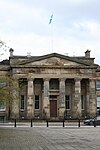
|
| 1-16 (inclusive Nos) Buckingham Terrace, 2, 4 Buckingham Street, 1, 3 Ruskin Place | Great Western Road | 15 December 1970 | NS5702967267 | 55°52′38″N 4°17′13″W / 55.877279°N 4.286879°W | J T Rochead, 1852-54. | 32850 | ![1-16 (inclusive Nos) Buckingham Terrace [de], 2, 4 Buckingham Street, 1, 3 Ruskin Place](http://upload.wikimedia.org/wikipedia/commons/thumb/7/70/Buckingham_Terrace_%28geograph_3654946%29.jpg/150px-Buckingham_Terrace_%28geograph_3654946%29.jpg)
|
| Lilybank House | University of Glasgow, Gilmorehill Campus | 15 December 1970 | NS5679666912 | 55°52′26″N 4°17′25″W / 55.874023°N 4.290412°W | In the style of David Hamilton, built around 1850 and altered by A & G Thomson (1863-65) and Honeyman, Keppie & Mackintosh (1894-95; 1900 and 1908). | 32853 | 
|
| 35-51 (Odd Nos) Hamilton Drive, (1-9 Inclusive Nos) Northpark Terrace | Kelvinside | 15 December 1970 | NS5709767277 | 55°52′39″N 4°17′09″W / 55.877389°N 4.285798°W | Alexander Thomson, circa 1869. | 32874 | ![35-51 (Odd Nos) Hamilton Drive [de], (1-9 Inclusive Nos) Northpark Terrace](http://upload.wikimedia.org/wikipedia/commons/thumb/3/3b/35-51_%28Odd_Nos%29_Hamilton_Drive%2C.jpg/150px-35-51_%28Odd_Nos%29_Hamilton_Drive%2C.jpg)
|
| Cottier Theatre Complex | 93-95 (Odd Nos) Hyndland Street | 15 December 1970 | NS5607866959 | 55°52′27″N 4°18′07″W / 55.874231°N 4.301902°W | William Leiper 1865-66. Former Dowanhill Church and Halls. | 32879 | 
|
| Woodbank [de | 56 Partickhill Road | 15 December 1970 | NS5566267007 | 55°52′28″N 4°18′31″W / 55.874537°N 4.308571°W | Circa 1841. | 32895 | 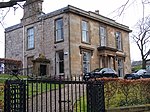
|
| 1-9 (Inclusive Nos) Ruskin Terrace, 1, 1A, 3 Hamilton Park Avenue | 15 December 1970 | NS5723167155 | 55°52′35″N 4°17′01″W / 55.876334°N 4.283594°W | Circa 1855-58. | 32903 | ![1-9 (Inclusive Nos) Ruskin Terrace [de], 1, 1A, 3 Hamilton Park Avenue](http://upload.wikimedia.org/wikipedia/commons/thumb/c/c5/Ruskin_Terrace_%28geograph_2460531%29.jpg/150px-Ruskin_Terrace_%28geograph_2460531%29.jpg)
| |
| Wellington Church | 76 University Avenue | 6 July 1966 | NS5700466748 | 55°52′21″N 4°17′13″W / 55.872612°N 4.287004°W | T L Watson, 1882-84. | 32912 | 
|
| Gilbert Scott Building and Memorial Chapel (with the Lion and Unicorn Staircase) | University of Glasgow, Gilmorehill Campus | 15 December 1970 | NS5687866664 | 55°52′19″N 4°17′20″W / 55.871821°N 4.288971°W | Sir George Gilbert Scott (N, S and E elevations), 1867-1870; tower and spire finished 1891 by John Oldrid Scott. Later made into 2 quadrangles with the addition of Bute and Randolph Halls, designed by Sir George Gilbert Scott and executed by his son, John Oldrid Scott, and Edwin Morgan, 1878-84. West Quadrangle Sir John James Burnet, 1923-29. Lion and Unicorn Staircase, William Riddell, 1690 | 32913 | 
|
| Joseph Black Building | University of Glasgow, Gilmorehill Campus | 15 January 1985 | NS5661466700 | 55°52′19″N 4°17′36″W / 55.872065°N 4.293206°W | T Harold Hughes with D S R Waugh, 1936-9. | 32918 | 
|
| Pearce Lodge | University of Glasgow, Gilmorehill Campus | 15 December 1970 | NS5707066668 | 55°52′19″N 4°17′09″W / 55.871914°N 4.285908°W | A G Thomson, Architect & Civil Engineer, 1887. Incorporates decorative mid 17th-century sculptural fragments from demolished Old College (High Street) into exterior. | 32925 | 
|
| McMillan Reading Room | University of Glasgow, Gilmorehill Campus | 15 January 1985 | NS5693966755 | 55°52′22″N 4°17′17″W / 55.872656°N 4.288045°W | T Harold Hughes and D S R Waugh, 1936-39. | 32927 | 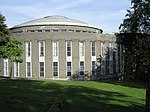
|
| Graham Kerr Building | University of Glasgow, Gilmorehill Campus | 15 December 1970 | NS5662566631 | 55°52′17″N 4°17′35″W / 55.871449°N 4.292994°W | Sir John James Burnet, 1923-27 | 32928 | 
|
| 2-10 (inclusive) University Gardens | University of Glasgow, Gilmorehill Campus | 15 December 1970 | NS5680766794 | 55°52′23″N 4°17′25″W / 55.872967°N 4.290174°W | John James Burnet, 1882-96. | 32931 | 
|
| Salmon House (12 University Gardens) | University of Glasgow, Gilmorehill Campus | 15 December 1970 | NS5677966820 | 55°52′23″N 4°17′26″W / 55.873192°N 4.290635°W | J Gaff Gillespie, 1900. | 32932 | 
|
| 14 University Gardens | University of Glasgow, Gilmorehill Campus | 15 December 1970 | NS5677366830 | 55°52′24″N 4°17′27″W / 55.87328°N 4.290736°W | John James Burnet, 1904. | 32933 | 
|
| The Salon [de | 17 Vinicombe Street | 22 March 1977 | NS5679167237 | 55°52′37″N 4°17′26″W / 55.876939°N 4.290664°W | Brand and Lithgow, 1913; altered 1931 by James McKissack and 1940 by Burnet and Boston, converted to Salon restaurant 2007. | 32934 | 
|
| Former Botanic Gardens Garage | 24 Vinicombe Street | 6 February 1989 | NS5683867267 | 55°52′38″N 4°17′24″W / 55.877222°N 4.289929°W | D V Wyllie, circa 1906-12. | 32935 | 
|
| Savings Bank of Glasgow | 752-756 (Even Nos) Argyle Street and 3, 5, 7 Shaftesbury Street | 15 December 1970 | NS5776665519 | 55°51′42″N 4°16′27″W / 55.861804°N 4.274191°W | James Salmon junior and J Gaff Gillespie, 1899-1900, sculpture by Albert Hodge. | 32953 | ![Savings Bank of Glasgow [de]](http://upload.wikimedia.org/wikipedia/commons/thumb/7/75/Former_Savings_Bank_of_Glasgow_%28geograph_3486736%29.jpg/150px-Former_Savings_Bank_of_Glasgow_%28geograph_3486736%29.jpg)
|
| 181-199 (Odd Nos) Bath Street and Blythswood Street | 15 December 1970 | NS5847165788 | 55°51′52″N 4°15′47″W / 55.864427°N 4.263077°W | Probably John Baird I, begun 1833; with later block by Andrew Robertson, 1930-2. Includes the Glasgow Art Club | 32960 | ![181-199 (Odd Nos) Bath Street [de] and Blythswood Street](http://upload.wikimedia.org/wikipedia/commons/thumb/d/da/181-199_%28Odd_Nos%29_Bath_Street.jpg/150px-181-199_%28Odd_Nos%29_Bath_Street.jpg)
| |
| King's Theatre | 335 Bath Street and Elmbank Street | 15 December 1970 | NS5811965874 | 55°51′54″N 4°16′07″W / 55.865095°N 4.268741°W | Frank Matcham, 1903-04. | 32963 | 
|
| Mercantile Chambers | 39-69 (Odd Nos) Bothwell Street | 15 December 1970 | NS5858165401 | 55°51′40″N 4°15′40″W / 55.860985°N 4.261118°W | James Salmon junior, 1897-8. Sculptor Derwent Wood. | 32980 | ![Mercantile Chambers [de]](http://upload.wikimedia.org/wikipedia/commons/thumb/7/7c/Mercantile_Chambers.jpg/150px-Mercantile_Chambers.jpg)
|
| 2-28 (Even Nos) Bothwell Street, 123 Hope Street | 24 July 1973 | NS5871365426 | 55°51′40″N 4°15′32″W / 55.861248°N 4.259024°W | Alexander Kirkland and John Bryce, 1849. The western pavilion was replaced by the National Commercial Bank, H E Clifford 1892. | 32983 | ![2-28 (Even Nos) Bothwell Street [de], 123 Hope Street](http://upload.wikimedia.org/wikipedia/commons/thumb/7/7c/2-28_%28Even_Nos%29_Bothwell_Street.jpg/150px-2-28_%28Even_Nos%29_Bothwell_Street.jpg)
| |
| 21-31 (Odd Nos) (Known As 21) Buchanan Street and 8-28 (Even Nos) Mitchell Street | 15 December 1970 | NS5891865134 | 55°51′31″N 4°15′20″W / 55.858686°N 4.2556°W | William Spence, circa 1879. | 32991 | ![21-31 (Odd Nos) (Known As 21) Buchanan Street [de] and 8-28 (Even Nos) Mitchell Street](http://upload.wikimedia.org/wikipedia/commons/thumb/1/18/Fraser%27s%2C_Buchanan_St%2C_Glasgow%2C_2018-06-30_HDR.jpg/150px-Fraser%27s%2C_Buchanan_St%2C_Glasgow%2C_2018-06-30_HDR.jpg)
| |
| Former Wylie and Lochead's | 45 Buchanan Street and 34-50 (Even Nos) Mitchell Street | 23 March 1977 | NS5893165178 | 55°51′33″N 4°15′19″W / 55.859085°N 4.255415°W | South section of Buchanan Street frontage 1853-4. Central section James Sellars 1884. North section Boucher and Cousland after 1883. | 32992 | ![Former Wylie and Lochead's [de]](http://upload.wikimedia.org/wikipedia/commons/thumb/c/cb/45_Buchanan_Street%2C_Glasgow.jpg/84px-45_Buchanan_Street%2C_Glasgow.jpg)
|
| 91 Buchanan Street | 15 December 1970 | NS5897765269 | 55°51′36″N 4°15′17″W / 55.859916°N 4.254728°W | Sir George Washington Browne, 1896. | 32998 | ![91 Buchanan Street [de]](http://upload.wikimedia.org/wikipedia/commons/thumb/6/6c/91_Buchanan_Street_%28geograph_3755088%29.jpg/112px-91_Buchanan_Street_%28geograph_3755088%29.jpg)
| |
| 113-115 (Odd Nos) Buchanan Street and 4 Gordon Street | 15 December 1970 | NS5899965335 | 55°51′38″N 4°15′16″W / 55.860515°N 4.254411°W | A G Sydney Mitchell, 1887. | 33000 | ![113-115 (Odd Nos) Buchanan Street [de] and 4 Gordon Street](http://upload.wikimedia.org/wikipedia/commons/thumb/5/50/113-115_%28ODD_NOS%29_BUCHANAN_STREET_AND_4_GORDON_STREET.jpg/112px-113-115_%28ODD_NOS%29_BUCHANAN_STREET_AND_4_GORDON_STREET.jpg)
| |
| Former Western Club | 147 Buchanan Street and St Vincent Street | 15 December 1970 | NS5901865433 | 55°51′41″N 4°15′15″W / 55.8614°N 4.254159°W | D and J Hamilton with the assistance of J T Rochead, 1841. | 33002 | 
|
| St George's Tron Parish Church | 163 Buchanan Street | 6 July 1966 | NS5903265500 | 55°51′43″N 4°15′14″W / 55.862006°N 4.25397°W | William Stark, 1807. Church of Scotland. | 33003 | 
|
| Former Athenaeum Theatre | 179 Buchanan Street | 6 July 1966 | NS5903765562 | 55°51′45″N 4°15′14″W / 55.862564°N 4.253923°W | Sir J J Burnet and J A Campbell, 1891-3. | 33004 | ![Former Athenaeum Theatre [de]](http://upload.wikimedia.org/wikipedia/commons/thumb/a/a1/The_Old_Athanaeum%2C_Buchanan_Street%2C_Glasgow.jpg/112px-The_Old_Athanaeum%2C_Buchanan_Street%2C_Glasgow.jpg)
|
| No 4 Clairmont Gardens | 15 December 1970 | NS5759266077 | 55°52′00″N 4°16′38″W / 55.866762°N 4.277262°W | Previously included in listing of nos 2-13 Clairmont Gardens. Up-graded B to A 28 September 1994 and included as a separate item due to high quality of interior work. | 33008 | 
| |
| Former Custom House | 298-306 (Even Nos) Clyde Street | 15 December 1970 | NS5884764881 | 55°51′23″N 4°15′24″W / 55.856394°N 4.256601°W | John Taylor, 1840. Now Office of Procurator Fiscal. | 33012 | ![Former Custom House [de]](http://upload.wikimedia.org/wikipedia/commons/thumb/b/b6/Custom_House_-_geograph.org.uk_-_943624.jpg/150px-Custom_House_-_geograph.org.uk_-_943624.jpg)
|
| 49 Derby Street, 22, 30 Bentinck Street | 6 July 1966 | NS5711766068 | 55°52′00″N 4°17′05″W / 55.866541°N 4.284841°W | James Sellars, 1879-80. | 33015 | ![49 Derby Street [de], 22, 30 Bentinck Street](http://upload.wikimedia.org/wikipedia/commons/thumb/0/09/Former_Kelvingrove_Parish_Church%2C_Derby_Street%2C_Glasgow.jpg/150px-Former_Kelvingrove_Parish_Church%2C_Derby_Street%2C_Glasgow.jpg)
| |
| 17-21 (Odd Nos) Drury Street | Including "The Horse Shoe Bar" | 21 July 1988 | NS5887365371 | 55°51′39″N 4°15′23″W / 55.860801°N 4.256441°W | Circa 1870, interior remodelled 1885-87 and 1901. Unknown architect, after Alexander Thomson. | 33016 | 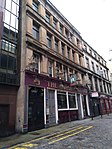
|
| 120 Elmbank Street with 71-83 (Odd Nos) Holland Street and Lodges, 59, 61 Holland Street | 15 December 1970 | NS5817865784 | 55°51′51″N 4°16′04″W / 55.864305°N 4.267752°W | Main block, Charles Wilson, 1846. Sculptures by John Mossman. 71-83 Holland St: J L Cowan, completed 1897. Science Block: John Watson 1931-32. Lodges, Holland St: Watson, Salmond and Gray, 1938. | 33022 | ![120 Elmbank Street [de] with 71-83 (Odd Nos) Holland Street and Lodges, 59, 61 Holland Street](http://upload.wikimedia.org/wikipedia/commons/thumb/d/d3/120%2C_Elmbank_Street_with_71-83_%28Odd_Nos%29_Holland_Street_and_Lodges%2C_59%2C_61_Holland_Street.jpg/150px-120%2C_Elmbank_Street_with_71-83_%28Odd_Nos%29_Holland_Street_and_Lodges%2C_59%2C_61_Holland_Street.jpg)
| |
| Central Station & Hotel | Gordon Street | 15 December 1970 | NS5872765252 | 55°51′35″N 4°15′31″W / 55.85969°N 4.25871°W | Sir R Rowand Anderson, 1883-4. Extensive additions to Hope Street, James Miller 1900-1907. | 33029 | 
|
| 6 Gordon Street, Part of Former Commercial Bank | 6 July 1966 | NS5895965350 | 55°51′38″N 4°15′18″W / 55.860638°N 4.255058°W | David Rhind, 1854-7. | 33030 | ![6 Gordon Street [de], Part of Former Commercial Bank](http://upload.wikimedia.org/wikipedia/commons/thumb/c/c4/6_Gordon_Street%2C_Glasgow.jpg/150px-6_Gordon_Street%2C_Glasgow.jpg)
| |
| 20-40 (Even Nos) Gordon Street and 1, 3 West Nile Street | 15 December 1970 | NS5889765358 | 55°51′38″N 4°15′22″W / 55.860691°N 4.256052°W | Peddie and Kinnear, 1873. | 33031 | ![20-40 (Even Nos) Gordon Street [de] and 1, 3 West Nile Street](http://upload.wikimedia.org/wikipedia/commons/thumb/c/c7/20-40_%28Even_Nos%29_Gordon_Street_and_1%2C_3_West_Nile_Street.jpg/150px-20-40_%28Even_Nos%29_Gordon_Street_and_1%2C_3_West_Nile_Street.jpg)
| |
| Grosvenor Building | 72-80 (Even Nos) Gordon Street | 15 December 1970 | NS5879365372 | 55°51′39″N 4°15′28″W / 55.860786°N 4.257719°W | Alexander Thomson, 1864, with later additional storeys by J H Craigie, 1902-07. | 33034 | ![Grosvenor Building [de]](http://upload.wikimedia.org/wikipedia/commons/thumb/c/c6/Grosvenor_Building.jpg/112px-Grosvenor_Building.jpg)
|
| Mitchell Theatre | Granville Street, Berkeley Street and Kent Road | 6 July 1966 | NS5782365843 | 55°51′53″N 4°16′24″W / 55.86473°N 4.273451°W | James Sellars, 1873-77, interior reconstructed. Sculpture by John Mossman at 1st floor. William Mossman at ground floor. Formerly St Andrew's Halls. | 33036 | 
|
| Breadalbane Terrace | 97-113B (Odd Nos) Hill Street | 15 December 1970 | NS5832466078 | 55°52′01″N 4°15′56″W / 55.866987°N 4.265575°W | Possibly Charles Wilson. Built in 2 sections 1845-6 and 1855-6. | 33038 | ![Breadalbane Terrace [de]](http://upload.wikimedia.org/wikipedia/commons/thumb/5/57/Breadalbane_Terrace.jpg/150px-Breadalbane_Terrace.jpg)
|
| Hill Street Synagogue | 129 Hill Street and 29 Garnet Street | 27 November 1979 | NS5819166096 | 55°52′02″N 4°16′04″W / 55.86711°N 4.267708°W | John McLeod, in association with N.S. Joseph, 1877-79. | 33040 | 
|
| Peel Terrace | 102-112 (Even Nos) Hill Street, and 37, 39 Garnethill Street | 11 May 1981 | NS5831066135 | 55°52′03″N 4°15′57″W / 55.867495°N 4.265828°W | 1841-2. Possibly David Hamilton. | 33044 | ![Peel Terrace [de]](http://upload.wikimedia.org/wikipedia/commons/thumb/a/a9/Hill_Street_-_geograph.org.uk_-_1179342.jpg/112px-Hill_Street_-_geograph.org.uk_-_1179342.jpg)
|
| Atlantic Chambers | 43, 45, 47 Hope Street and 1A Cadogan Street | 15 December 1970 | NS5867665241 | 55°51′34″N 4°15′34″W / 55.859576°N 4.259519°W | Sir J J Burnet, 1899. | 33050 | ![Atlantic Chambers [de]](http://upload.wikimedia.org/wikipedia/commons/thumb/0/06/Atlantic_Chambers.jpg/112px-Atlantic_Chambers.jpg)
|
| Central Chambers [de | 91-115 (Odd Nos) Hope Street, 2-14 (Even Nos) Waterloo Street and 1-13 (Odd Nos) Bothwell Street | 15 December 1970 | NS5868565349 | 55°51′38″N 4°15′34″W / 55.860548°N 4.259431°W | Peddie and Kinnear, 1876-77. | 33052 | 
|
| 157-167 (Odd Nos) Hope Street and 169-175 (Odd Nos) West George Street | 6 July 1966 | NS5874765544 | 55°51′44″N 4°15′31″W / 55.862317°N 4.258543°W | John A Campbell, 1902. | 33053 | ![157-167 (Odd Nos) Hope Street [de] and 169-175 (Odd Nos) West George Street](http://upload.wikimedia.org/wikipedia/commons/thumb/8/8d/157-167_%28Odd_Nos%29_Hope_Street_and_169-175_%28Odd_Nos%29_West_George_Street.jpg/112px-157-167_%28Odd_Nos%29_Hope_Street_and_169-175_%28Odd_Nos%29_West_George_Street.jpg)
| |
| 106, 108, 110 Hope Street (Known As 108) | 15 December 1979 | NS5876165413 | 55°51′40″N 4°15′30″W / 55.861145°N 4.258251°W | W Forrest Salmon, 1894 assisted by J Gaff Gillespie and James Salmon, sculpture by W Ferris. | 33056 | ![106, 108, 110 Hope Street [de] (Known As 108)](http://upload.wikimedia.org/wikipedia/commons/thumb/7/7a/106%2C_108_Hope_Street%2C_Scottish_Temperance_League_Offices.jpg/84px-106%2C_108_Hope_Street%2C_Scottish_Temperance_League_Offices.jpg)
| |
| Lion Chambers | 170, 172 Hope Street | 6 July 1966 | NS5882665673 | 55°51′49″N 4°15′26″W / 55.863498°N 4.257349°W | James Salmon Jr., 1905. | 33059 | 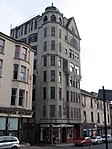
|
| Theatre Royal | 282 Hope Street, Cowcaddens | 22 March 1977 | NS5890565980 | 55°51′59″N 4°15′22″W / 55.866278°N 4.256248°W | George Bell, 1867; burnt down 1879, restoration after fire by Charles J Phipps, 1880. Further fire, also rebuilt by Phipps, 1895, in similar scheme to previous one; altered James Miller 1901; restored and new foyer Derek Sugden of Arup Associates 1974-5. | 33061 | 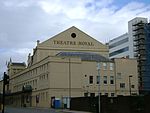
|
| Gardner's Warehouse | 36 Jamaica Street and 10 Midland Street | 6 July 1966 | NS5879865017 | 55°51′27″N 4°15′27″W / 55.857601°N 4.257454°W | John Baird I and R McConnel iron founder, 1855-56. Early example of Iron Frame architecture.[17] | 33065 | ![Gardner's Warehouse [de]](http://upload.wikimedia.org/wikipedia/commons/thumb/c/c8/Gardners_Warehouse%2C_Jamaica_Street_Glasgow.jpg/150px-Gardners_Warehouse%2C_Jamaica_Street_Glasgow.jpg)
|
| Atlantic Apartments | 69 James Watt Street | 15 December 1970 | NS5838365127 | 55°51′30″N 4°15′51″W / 55.858467°N 4.264136°W | Circa 1855. | 33068 | ![Atlantic Apartments [de]](http://upload.wikimedia.org/wikipedia/commons/thumb/2/2d/69_James_Watt_Street.jpg/150px-69_James_Watt_Street.jpg)
|
| 44-54 James Watt Street | 15 December 1970 | NS5840165104 | 55°51′30″N 4°15′50″W / 55.858265°N 4.263837°W | Circa 1863. | 33069 | ![44-54 James Watt Street [de]](http://upload.wikimedia.org/wikipedia/commons/thumb/6/6a/44-54_James_Watt_Street.jpg/150px-44-54_James_Watt_Street.jpg)
| |
| 66-72 James Watt Street | 15 December 1970 | NS5840165104 | 55°51′30″N 4°15′50″W / 55.858265°N 4.263837°W | Probably J Stephen 1847-8. | 33070 | ![66-72 James Watt Street [de]](http://upload.wikimedia.org/wikipedia/commons/thumb/6/63/66_watt_st_glasgow.jpg/150px-66_watt_st_glasgow.jpg)
| |
| Kelvingrove Art Gallery and Museum | Kelvingrove Park | 15 December 1970 | NS5676266309 | 55°52′07″N 4°17′26″W / 55.868599°N 4.290636°W | J W Simpson and Milner Allen, 1892 by competition, completed 1901; sculpture supervised and partly executed by George Frampton, other sculptors involved, W Birnie Rhind, E G Bramwell, Johann Keller, A McF Shannon, F Derwent Wood, A Falkner. | 33071 | 
|
| Hindu Mandir | 1 La Belle Place | 6 July 1966 | NS5746766059 | 55°52′00″N 4°16′45″W / 55.866564°N 4.279248°W | Charles Wilson, 1857. Former Queen's Rooms. | 33082 | ![Hindu Mandir [de]](http://upload.wikimedia.org/wikipedia/commons/thumb/f/f2/1_La_Belle_Place.jpg/150px-1_La_Belle_Place.jpg)
|
| 2–5 La Belle Place | 15 December 1970 | NS5743366058 | 55°52′00″N 4°16′47″W / 55.866545°N 4.27979°W | Charles Wilson, 1857. | 33083 | ![2–5 La Belle Place [de]](http://upload.wikimedia.org/wikipedia/commons/thumb/3/3d/2-5_%28inclusive_Nos%29_La_Belle_Place.jpg/150px-2-5_%28inclusive_Nos%29_La_Belle_Place.jpg)
| |
| Former Glasgow Herald Building | 60-76 (Even Nos) Mitchell Street | 15 December 1970 | NS5892465238 | 55°51′35″N 4°15′20″W / 55.859622°N 4.255558°W | John Keppie and Charles Rennie Mackintosh, 1893-5. | 33087 | 
|
| Glasgow Stock Exchange | 63-77 (Odd Nos) Nelson Mandela Place, West George Street with 153-159 (Odd Nos) Buchanan Street | 15 December 1970 | NS5902465464 | 55°51′42″N 4°15′15″W / 55.86168°N 4.254079°W | John Burnet 1875-7; Sir J J Burnet western addition 1894-8 and 1904, re-cast behind the facade. | 33089 | 
|
| Former Daily Record Building | 20, 26, 28 Renfield Lane and St Vincent Lane | 15 December 1970 | NS5878865410 | 55°51′40″N 4°15′28″W / 55.861126°N 4.257819°W | Charles Rennie Mackintosh, 1900-01 and 1903-04. | 33099 | ![Former Daily Record Building [de]](http://upload.wikimedia.org/wikipedia/commons/thumb/1/1c/The_Daily_Record_Printing_Works_in_Renfield_Lane_-_panoramio.jpg/112px-The_Daily_Record_Printing_Works_in_Renfield_Lane_-_panoramio.jpg)
|
| Pavilion Theatre | 121-125 Renfield Street | 22 March 1977 | NS5893065844 | 55°51′54″N 4°15′21″W / 55.865064°N 4.255778°W | Bertie Crewe, 1902-4. | 33103 | 
|
| Glasgow School of Art | 167 Renfrew Street and 11, 15 Dalhousie Street | 6 July 1966 | NS5843565969 | 55°51′58″N 4°15′49″W / 55.866041°N 4.263746°W | Charles Rennie Mackintosh, Eastern section, 1897. Western section, 1907-9. | 33105 | 
|
| 71–75 Robertson Street and 58, 60 Robertson Lane | 15 December 1970 | NS5854265096 | 55°51′30″N 4°15′42″W / 55.858235°N 4.261582°W | J A Campbell 1901. | 33112 | ![71–75 Robertson Street [de] and 58, 60 Robertson Lane](http://upload.wikimedia.org/wikipedia/commons/thumb/6/61/71-75_%28Odd_Nos%29_Robertson_Street_and_58%2C_60_Robertson_Lane.jpg/150px-71-75_%28Odd_Nos%29_Robertson_Street_and_58%2C_60_Robertson_Lane.jpg)
| |
| Clyde Navigation Trust | 16 Robertson Street | 6 July 1966 | NS5858664962 | 55°51′25″N 4°15′39″W / 55.857045°N 4.26081°W | Sir J J Burnet. 1883-6 North section. 1905-8 corner with Broomielaw. Sculpture by Albert Hodge. | 33113 | ![Clyde Navigation Trust [de]](http://upload.wikimedia.org/wikipedia/commons/thumb/4/44/Clydeport_building_-_geograph.org.uk_-_1481376.jpg/122px-Clydeport_building_-_geograph.org.uk_-_1481376.jpg)
|
| St Aloysius' Church (Roman Catholic) | 23, 25 Rose Street | 15 December 1970 | NS5855966016 | 55°51′59″N 4°15′42″W / 55.8665°N 4.261791°W | C J Menart, 1908-10. | 33115 | 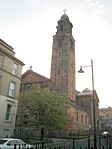
|
| Charing Cross Mansions | 2-30 (Even Nos) St George's Road, 540-546 (Even Nos) Sauchiehall Street and 357,359 Renfrew Street | 15 December 1970 | NS5801766047 | 55°52′00″N 4°16′14″W / 55.866619°N 4.27046°W | Sir J J Burnet, 1891. | 33127 | ![Charing Cross Mansions [de]](http://upload.wikimedia.org/wikipedia/commons/thumb/e/e4/Charing_Cross_Mansions%2C_Glasgow_%28geograph_4137464%29.jpg/150px-Charing_Cross_Mansions%2C_Glasgow_%28geograph_4137464%29.jpg)
|
| 19–30 St Vincent Crescent (Excluding Nos 23, 23A, 23B, 26A) and 21 Corunna Street | 15 December 1970 | NS5720465704 | 55°51′48″N 4°17′00″W / 55.863299°N 4.28326°W | Alexander Kirkland, circa 1855. | 33128 | ![19–30 St Vincent Crescent [de] (Excluding Nos 23, 23A, 23B, 26A) and 21 Corunna Street](http://upload.wikimedia.org/wikipedia/commons/thumb/f/fb/Minerva_Street_at_St_Vincent_Crescent_-_geograph.org.uk_-_666286.jpg/150px-Minerva_Street_at_St_Vincent_Crescent_-_geograph.org.uk_-_666286.jpg)
| |
| 31–70 St Vincent Crescent (Excluding Nos 35A,36A,37A,39A) and 30 Corunna Street | 15 December 1970 | NS5685865806 | 55°51′51″N 4°17′20″W / 55.864112°N 4.288837°W | Alexander Kirkland, 1850 onwards. | 33129 | ![31–70 St Vincent Crescent [de] (Excluding Nos 35A,36A,37A,39A) and 30 Corunna Street](http://upload.wikimedia.org/wikipedia/commons/thumb/6/66/St_Vincent_Crescent_-_geograph.org.uk_-_890077.jpg/150px-St_Vincent_Crescent_-_geograph.org.uk_-_890077.jpg)
| |
| 115–117 St Vincent Street | 15 December 1970 | NS5878765434 | 55°51′41″N 4°15′28″W / 55.861341°N 4.257847°W | John Burnet Sr, 1870. | 33138 | ![115–117 St Vincent Street [de]](http://upload.wikimedia.org/wikipedia/commons/thumb/4/4d/115%2C_115a%2C_117_St_Vincent_Street%2C_Glasgow.jpg/84px-115%2C_115a%2C_117_St_Vincent_Street%2C_Glasgow.jpg)
| |
| St Vincent Street Church | 261 St Vincent Street | 6 July 1966 | NS5831365551 | 55°51′44″N 4°15′56″W / 55.862253°N 4.265475°W | Alexander Thomson, 1857-59. Former United Free Church of Scotland, now Free Church. | 33150 | 
|
| 84–94 St Vincent Street | 15 December 1970 | NS5890765456 | 55°51′42″N 4°15′21″W / 55.861574°N 4.255943°W | John A Campbell 1908-9. | 33153 | ![84–94 St Vincent Street [de]](http://upload.wikimedia.org/wikipedia/commons/thumb/c/ce/84-94_%28Even_Nos%29_St_Vincent_Street.jpg/112px-84-94_%28Even_Nos%29_St_Vincent_Street.jpg)
| |
| Bank of Scotland (110–120 St Vincent Street) | 110, 120 St Vincent Street and 29-37 (Odd Nos) Renfield Street and West George Lane | 15 December 1970 | NS5883665490 | 55°51′43″N 4°15′26″W / 55.861858°N 4.257094°W | James Miller, 1925-27. | 33156 | ![Bank of Scotland (110–120 St Vincent Street [de])](http://upload.wikimedia.org/wikipedia/commons/thumb/f/f7/110%2C_120_St_Vincent_Street_and_29-37_%28Odd_Nos%29_Renfield_Street_and_West_George_Lane.jpg/112px-110%2C_120_St_Vincent_Street_and_29-37_%28Odd_Nos%29_Renfield_Street_and_West_George_Lane.jpg)
|
| Royal Bank Building [de | 140, 142 St Vincent Street and 153, 155 Hope Street | 21 July 1988 | NS5874765494 | 55°51′43″N 4°15′31″W / 55.861868°N 4.258517°W | Burnet and Boston, circa 1900. | 33159 | 
|
| 142a–144 St Vincent Street | The "Hatrack" | 6 July 1966 | NS5873765497 | 55°51′43″N 4°15′31″W / 55.861892°N 4.258678°W | James Salmon Jnr, 1899-1902. | 33160 | ![142a–144 St Vincent Street [de]](http://upload.wikimedia.org/wikipedia/commons/thumb/e/e2/142A%2C_144_St_Vincent_Street.jpg/112px-142A%2C_144_St_Vincent_Street.jpg)
|
| 200 St Vincent Street | 6 July 1966 | NS5859665543 | 55°51′44″N 4°15′39″W / 55.862264°N 4.260953°W | Sir J J Burnet, 1926-9, major internal remodelling 1986/7. | 33162 | ![200 St Vincent Street [de]](http://upload.wikimedia.org/wikipedia/commons/thumb/b/bf/200_St_Vincent_Street.jpg/112px-200_St_Vincent_Street.jpg)
| |
| Willow Tearooms | 217 Sauchiehall Street | 15 December 1970 | NS5859465838 | 55°51′54″N 4°15′40″W / 55.864912°N 4.261139°W | Designed by Charles Rennie Mackintosh and Margaret Macdonald in 1903. | 33173 | 
|
| 901–903 Sauchiehall Street | 15 December 1970 | NS5712865932 | 55°51′55″N 4°17′05″W / 55.865323°N 4.284593°W | Charles Wilson, 1853. | 33184 | ![901–903 Sauchiehall Street [de]](http://upload.wikimedia.org/wikipedia/commons/thumb/4/4c/901%2C_903_Sauchiehall_Street.jpg/150px-901%2C_903_Sauchiehall_Street.jpg)
| |
| 336-356 (Even Nos) Sauchiehall Street and 1 Scott Street | 15 December 1970 | NS5835265943 | 55°51′57″N 4°15′54″W / 55.865783°N 4.265057°W | Alexander Thomson, 1865. | 33193 | ![336-356 (Even Nos) Sauchiehall Street [de] and 1 Scott Street](http://upload.wikimedia.org/wikipedia/commons/thumb/e/e8/336-356_Sauchiehall_Street%2C_Grecian_Chambers.jpg/150px-336-356_Sauchiehall_Street%2C_Grecian_Chambers.jpg)
| |
| Albany Chambers | 528-538 (Even Nos) Sauchiehall Street | 15 December 1970 | NS5804066017 | 55°51′59″N 4°16′12″W / 55.866356°N 4.270077°W | Sir J J Burnet, 1896-7. | 33199 | ![Albany Chambers [de]](http://upload.wikimedia.org/wikipedia/commons/thumb/e/ee/534_Sauchiehall_Street%2C_Albany_Chambers.jpg/84px-534_Sauchiehall_Street%2C_Albany_Chambers.jpg)
|
| The Egyptian Halls | 84-100 Union Street | 6 July 1966 | NS5886165263 | 55°51′35″N 4°15′24″W / 55.859828°N 4.256577°W | Alexander Thomson, 1871-3. | 33208 | 
|
| Ca d’Oro Building | 122-136 (Even Nos) Union Street and 41-55 (Odd Nos) Gordon Street and Union Place | 15 December 1970 | NS5886465320 | 55°51′37″N 4°15′24″W / 55.86034°N 4.256559°W | John Honeyman, 1872. | 33209 | 
|
| Former Waterloo Street Post Office, Parcels Office | 50 Waterloo Street with 81 Wellington Street | 15 December 1970 | NS5858365364 | 55°51′38″N 4°15′40″W / 55.860653°N 4.261067°W | W T Oldrieve (for the Office of Works), 1903-05. | 33214 | ![Former Waterloo Street Post Office [de], Parcels Office](http://upload.wikimedia.org/wikipedia/commons/thumb/f/f4/Former_Waterloo_Street_Post_Office%2C_Parcels_Office.jpg/150px-Former_Waterloo_Street_Post_Office%2C_Parcels_Office.jpg)
|
| Former Sun Life Building | 117, 121 West George Street and 38-42 (Even Nos) Renfield Street | 15 December 1970 | NS5889365510 | 55°51′43″N 4°15′22″W / 55.862055°N 4.256195°W | William Leiper, 1889-94. | 33223 | ![Former Sun Life Building [de]](http://upload.wikimedia.org/wikipedia/commons/thumb/0/01/117%2C_121_West_George_Street.jpg/112px-117%2C_121_West_George_Street.jpg)
|
| 4 Nelson Mandela Place | 15 December 1970 | NS5904965538 | 55°51′44″N 4°15′13″W / 55.862352°N 4.253719°W | A N Paterson, 1908-10. | 33233 | ![4 Nelson Mandela Place [de]](http://upload.wikimedia.org/wikipedia/commons/thumb/a/a4/4_Nelson_Mandela_Place.jpg/112px-4_Nelson_Mandela_Place.jpg)
| |
| Former Athenaeum de | 8 Nelson Mandela Place | 6 July 1966 | NS5902465544 | 55°51′45″N 4°15′15″W / 55.862398°N 4.254121°W | Sir J J Burnet, 1886. | 33234 | 
|
| Royal Faculty of Procurators | 68 West George Street, 12 Nelson Mandela Place | 6 July 1966 | NS5899265526 | 55°51′44″N 4°15′17″W / 55.862227°N 4.254622°W | Charles Wilson, 1854. | 33235 | 
|
| Cornhill House | 144, 146 West George Street | 15 December 1970 | NS5882965580 | 55°51′46″N 4°15′26″W / 55.862664°N 4.257253°W | James Sellars, 1879 with sculpture by William Mossman. | 33241 | ![Cornhill House [de]](http://upload.wikimedia.org/wikipedia/commons/thumb/6/6b/144%2C_146_West_George_Street-2.jpg/112px-144%2C_146_West_George_Street-2.jpg)
|
| 196–198 West George Street and 118 Wellington Street | 15 December 1970 | NS5870265604 | 55°51′46″N 4°15′33″W / 55.862843°N 4.259293°W | Circa 1830. Probably by John Brash. | 33246 | ![196–198 West George Street [de] and 118 Wellington Street](http://upload.wikimedia.org/wikipedia/commons/thumb/a/ab/Wellington_Street_-_geograph.org.uk_-_995605.jpg/115px-Wellington_Street_-_geograph.org.uk_-_995605.jpg)
| |
| Finnieston Crane | Stobcross Quay | 14 April 1989 | NS5710365150 | 55°51′30″N 4°17′04″W / 55.858295°N 4.28458°W | 1926, completed 1931 by Cowans Sheldon and Co Ltd under the supervision of Daniel Fife Mechanical Engineer to the Clyde Navigation Trust. | 33285 | 
|
| 140–142 Balgrayhill Road, including Redclyffe | 22 March 1977 | NS6060768368 | 55°53′18″N 4°13′49″W / 55.888213°N 4.230303°W | Charles Rennie Mackintosh, 1890, for his cousin James Hamilton. | 33288 | ![140–142 Balgrayhill Road [de], including Redclyffe](http://upload.wikimedia.org/wikipedia/commons/thumb/4/43/140%2C_142_Balgrayhill_Road%2C_including_Redclyffe.jpg/150px-140%2C_142_Balgrayhill_Road%2C_including_Redclyffe.jpg)
| |
| Springburn Winter Gardens | Springburn Park | 22 March 1985 | NS6081468448 | 55°53′20″N 4°13′37″W / 55.888991°N 4.227037°W | Simpson and Farmer, hothouse builders, with William Baird of Temple ironworks, 1899-1900. | 33298 | 
|
| Elder Cottage Hospital | 1A Drumoyne Drive and Langlands Road | 15 December 1970 | NS5440865496 | 55°51′38″N 4°19′40″W / 55.860595°N 4.327783°W | Sir John James Burnet, 1902. | 33300 | ![Elder Cottage Hospital [de]](http://upload.wikimedia.org/wikipedia/commons/thumb/9/92/Former_Elder_Cottage_Hospital_-_geograph.org.uk_-_734464.jpg/150px-Former_Elder_Cottage_Hospital_-_geograph.org.uk_-_734464.jpg)
|
| Statue of Mrs John Elder | Elder Park | 15 December 1970 | NS5455265587 | 55°51′41″N 4°19′32″W / 55.861455°N 4.325534°W | By Archibald McFarlane Shannan, RSA. | 33304 | ![Statue of Mrs John Elder [de]](http://upload.wikimedia.org/wikipedia/commons/thumb/6/6c/Statue_of_Isabella_Elder.JPG/150px-Statue_of_Isabella_Elder.JPG)
|
| Elder Park Library | 228A Langlands Road and Elder Park Street | 15 December 1970 | NS5477765640 | 55°51′43″N 4°19′19″W / 55.861999°N 4.32197°W | Sir John James Burnet, 1902-3. | 33310 | ![Elder Park Library [de]](http://upload.wikimedia.org/wikipedia/commons/thumb/8/84/Elder_Park_Library.jpg/150px-Elder_Park_Library.jpg)
|
| Govan Graving Docks | 18 Clydebrae Street | 15 May 1987 | NS5609065462 | 55°51′39″N 4°18′03″W / 55.860795°N 4.300915°W | No 1 Dock (at North): by James Deas and Alex Lister, 1869-75. No 2 Dock (Centre): by James Deas, 1883-6. No 3 Dock (South): by James Deas, 1894-8. | 33336 | ![Govan Graving Docks [de]](http://upload.wikimedia.org/wikipedia/commons/thumb/4/44/016_Govan_Docks_%285143346967%29.jpg/150px-016_Govan_Docks_%285143346967%29.jpg)
|
| Former British Linen Bank | 816, 818 Govan Road, 1, 3 Water Row | 15 December 1970 | NS5542865763 | 55°51′48″N 4°18′42″W / 55.863299°N 4.311644°W | James Salmon and Son, and J G Gillespie, 1899. | 33351 | ![Former British Linen Bank [de]](http://upload.wikimedia.org/wikipedia/commons/thumb/8/81/Former_British_Linen_Bank_building_Govan.jpg/150px-Former_British_Linen_Bank_building_Govan.jpg)
|
| Pearce Institute | 840, 860 Govan Road | 6 July 1966 | NS5536265794 | 55°51′49″N 4°18′46″W / 55.863558°N 4.312714°W | Sir R Rowand Anderson, designed 1892, built 1902-5. | 33352 | ![Pearce Institute [de]](http://upload.wikimedia.org/wikipedia/commons/thumb/5/55/The_Pearce_Institute_-_geograph.org.uk_-_1756692.jpg/150px-The_Pearce_Institute_-_geograph.org.uk_-_1756692.jpg)
|
| Govan Old Parish Church | 866, 868 Govan Road | 6 July 1966 | NS5534965916 | 55°51′53″N 4°18′47″W / 55.864649°N 4.312986°W | Sir R Rowand Anderson 1883-8, chancel lengthened 1906 and dedicated in 1908. | 33353 | 
|
| Govan Shipbuilders Ltd, General Offices | 1030, 1048 Govan Road | 15 December 1970 | NS5468866024 | 55°51′56″N 4°19′25″W / 55.86542°N 4.323597°W | Honeyman and Keppie, 1890. Listing excludes the 1956 extension to the west. | 33356 | 
|
| Govan Shipbuilders' Store, Former Engine Works of Fairfield Shipbuilding and Engineering Company | 1048 Govan Road | 15 May 1987 | NS5468866024 | 55°51′56″N 4°19′25″W / 55.86542°N 4.323597°W | Angus Kennedy: 1st drawings December 1868, working details summer 1869, completed 1871, in full production 1874. | 33357 |  Upload Photo |
| Former Prince's Dock Hydraulic Power Station | 1 Pacific Quay | 15 December 1970 | NS5690865009 | 55°51′25″N 4°17′15″W / 55.856972°N 4.287618°W | Burnet, Son and Campbell, 1894. | 33360 | ![Former Prince's Dock Hydraulic Power Station [de]](http://upload.wikimedia.org/wikipedia/commons/thumb/0/09/The_Prince%27s_Dock%2C_%27FOUR_WINDS%27_hydraulic_power_station%2C_Glasgow._Accumulator_tower.jpg/150px-The_Prince%27s_Dock%2C_%27FOUR_WINDS%27_hydraulic_power_station%2C_Glasgow._Accumulator_tower.jpg)
|
| The Knowe | 301 Albert Drive | 15 December 1970 | NS5751663408 | 55°50′34″N 4°16′37″W / 55.842778°N 4.277073°W | Alexander Thomson, begun circa 1852. | 33371 | ![The Knowe [de]](http://upload.wikimedia.org/wikipedia/commons/thumb/9/99/The_Knowe.jpg/150px-The_Knowe.jpg)
|
| Miller and Lang Building | 50 Darnley Street, Pollokshields | 22 March 1977 | NS5799763409 | 55°50′35″N 4°16′10″W / 55.842929°N 4.269398°W | D B Dobson, 1902. Category A for the fine and exceptionally complete art nouveau office interiors on 1st floor. | 33402 | ![Miller and Lang Building [de]](http://upload.wikimedia.org/wikipedia/commons/thumb/8/8c/Miller_and_Lang_Building.jpg/150px-Miller_and_Lang_Building.jpg)
|
| Pollokshields Burgh Hall | 70 and 72 Glencairn Drive | 15 December 1970 | NS5685562973 | 55°50′19″N 4°17′15″W / 55.838677°N 4.28739°W | H E Clifford, 1888-90 with additions and alterations by Thomas Somers, Office of Public Works, 1935. | 33411 | 
|
| Ellisland | 200 Nithsdale Road | 15 December 1970 | NS5693863352 | 55°50′32″N 4°17′11″W / 55.842104°N 4.286266°W | Alexander Thomson, 1871. | 33450 |  Upload Photo |
| Castlehill (Glasgow) | 202 Nithsdale Road | 15 December 1970 | NS5689263367 | 55°50′32″N 4°17′13″W / 55.842225°N 4.287007°W | Alexander Thomson, 1870. | 33451 |  Upload Photo |
| Pollok House | 2060 Pollokshaws Road | 6 July 1966 | NS5490761802 | 55°49′39″N 4°19′04″W / 55.827582°N 4.317843°W | Possibly Allan Dreghorn. Dated 1752. | 33455 | 
|
| Bridge over White Cart Water at Pollok House | 2060 Pollokshaws Road | 6 July 1966 | NS5488661731 | 55°49′37″N 4°19′05″W / 55.826939°N 4.31814°W | Built 1757-8. | 33456 | 
|
| Stables of Pollok House | 2060 Pollokshaws Road | 6 July 1966 | NS5499461661 | 55°49′35″N 4°18′59″W / 55.826343°N 4.31638°W | Mainly 17th-19th century; formerly stables to Pollok house, but at site of previous house (the Laighe Castle) and containing much re-used 17th century work. Fragments at E corner said to be of c. 1536 tower. | 33457 | 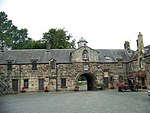
|
| Benefrey | 124 Springkell Avenue | 15 December 1970 | NS5577763054 | 55°50′21″N 4°18′17″W / 55.839083°N 4.304632°W | W Hunter McNab, 1910. | 33486 | ![Benefrey [de]](http://upload.wikimedia.org/wikipedia/commons/thumb/d/db/124_Springkell_Avenue.jpg/150px-124_Springkell_Avenue.jpg)
|
| Former Caledonia Road Church | 1 Caledonia Road | 6 July 1966 | NS5893263851 | 55°50′50″N 4°15′17″W / 55.847172°N 4.254709°W | Alexander Thomson, 1856. | 33497 | 
|
| 40-61 (Inclusive) Carlton Place and 16 Nicholson Street | 15 December 1970 | NS5891664582 | 55°51′13″N 4°15′19″W / 55.85373°N 4.255344°W | Peter Nicholson, 1802-4. No 50-53, Laurieston House has exceptional plaster work with columns, pilasters, swags and cherubs in vestibule and stair well. | 33499 | ![40-61 (Inclusive) Carlton Place [de] and 16 Nicholson Street](http://upload.wikimedia.org/wikipedia/commons/thumb/1/1a/Carlton_Place%2C_Glasgow%2C_Scotland.jpg/150px-Carlton_Place%2C_Glasgow%2C_Scotland.jpg)
| |
| Former Eglinton Engine Works | 27-117 (Odd Nos) Cook Street (Westbridge Gardens) and 181 and 183 West Street | 17 June 1986 | NS5830664278 | 55°51′03″N 4°15′54″W / 55.850822°N 4.264922°W | Built from circa 1855. | 33504 | ![Former Eglinton Engine Works [de]](http://upload.wikimedia.org/wikipedia/commons/thumb/b/bb/Former_Eglinton_Engine_Works.jpg/150px-Former_Eglinton_Engine_Works.jpg)
|
| 162–170 Gorbals Street | 15 December 1970 | NS5896764171 | 55°51′00″N 4°15′16″W / 55.850055°N 4.254317°W | James Salmon, Jr. 1900. Former British Linen Bank, shop and flats with Glasgow style detailing. | 33513 | ![162–170 Gorbals Street [de]](http://upload.wikimedia.org/wikipedia/commons/thumb/4/4e/162-170_%28Even_Nos%29_Gorbals_Street.jpg/112px-162-170_%28Even_Nos%29_Gorbals_Street.jpg)
| |
| Scotland Street School | 225 Scotland Street | 6 July 1966 | NS5775264142 | 55°50′58″N 4°16′25″W / 55.849438°N 4.273692°W | Charles Rennie Mackintosh between 1903 and 1907. | 33534 | 
|
| Craigie Hall | 6 Rowan Road, Dumbreck | 27 April 1978 | NS5554463935 | 55°50′49″N 4°18′32″W / 55.846923°N 4.308818°W | John Honeyman, 1872. Added to during the 1890s by his architectural partners John Keppie and Charles Rennie Mackintosh. | 33583 | ![Craigie Hall [de]](http://upload.wikimedia.org/wikipedia/commons/thumb/4/4e/Craigie_Hall%2C_Dumbreck%2C_Glasgow_%28geograph_2179733%29.jpg/150px-Craigie_Hall%2C_Dumbreck%2C_Glasgow_%28geograph_2179733%29.jpg)
|
| Leverndale Hospital, Towerview Unit | 510 Crookston Road | 15 December 1970 | NS5162462691 | 55°50′04″N 4°22′14″W / 55.834565°N 4.370688°W | Malcolm Stark and Rowntree, 1890-5. Additions by D Barclay, 1903. | 33597 | ![Leverndale Hospital, Towerview Unit [de]](http://upload.wikimedia.org/wikipedia/commons/thumb/5/50/Tower_at_Leverndale_Hospital_-_geograph.org.uk_-_87401.jpg/112px-Tower_at_Leverndale_Hospital_-_geograph.org.uk_-_87401.jpg)
|
| Former Springburn College | 110-136 (Even Nos) Flemington Street | 29 January 1990 | NS6056967426 | 55°52′47″N 4°13′50″W / 55.879745°N 4.230424°W | James Miller, 1903-9. | 33612 | ![Former Springburn College [de]](http://upload.wikimedia.org/wikipedia/commons/thumb/d/d7/North_Glasgow_College_-_geograph.org.uk_-_559277.jpg/150px-North_Glasgow_College_-_geograph.org.uk_-_559277.jpg)
|
| Tollcross House | 591 Tollcross Road | 15 December 1970 | NS6361963607 | 55°50′47″N 4°10′47″W / 55.84633°N 4.179787°W | David Bryce, 1848. | 33648 | ![Tollcross House [de]](http://upload.wikimedia.org/wikipedia/commons/thumb/9/97/Tollcross_House_-_geograph.org.uk_-_946123.jpg/150px-Tollcross_House_-_geograph.org.uk_-_946123.jpg)
|
| Daldowie Dovecot | Hamilton Road | 12 January 1971 | NS6677762899 | 55°50′27″N 4°07′45″W / 55.840856°N 4.129041°W | Mid 18th century cylindrical dovecot. | 33668 | 
|
| Southern Necropolis Lodge | 316 Caledonia Road, Rutherglen Road | 15 December 1970 | NS5951163475 | 55°50′38″N 4°14′43″W / 55.843965°N 4.245274°W | Charles Wilson, 1848. The main cemetery is Category B. | 33685 | 
|
| St Francis Church and Presbytery | 405, 407 Cumberland Street | 15 December 1970 | NS5949363749 | 55°50′47″N 4°14′45″W / 55.84642°N 4.245703°W | Gilbert Blount, 1868; rebuilt by Pugin & Pugin 1878-81, chancel and chapels completed 1895. | 33690 | ![St Francis Church and Presbytery [de]](http://upload.wikimedia.org/wikipedia/commons/thumb/2/25/St_Francis%27_RC_Church%2C_Hutchesontown_-_geograph.org.uk_-_1167971.jpg/150px-St_Francis%27_RC_Church%2C_Hutchesontown_-_geograph.org.uk_-_1167971.jpg)
|
| St Andrews Suspension Bridge | Adelphi Street/Glasgow Green | 23 March 1992 | NS5995964001 | 55°50′56″N 4°14′18″W / 55.848818°N 4.238397°W | Neil Robson and Charles O'Neill, 1853-5. | 33692 | ![St Andrews Suspension Bridge [de]](http://upload.wikimedia.org/wikipedia/commons/thumb/c/c5/St._Andrew%27s_Suspension_Bridge_-_geograph.org.uk_-_1079756.jpg/150px-St._Andrew%27s_Suspension_Bridge_-_geograph.org.uk_-_1079756.jpg)
|
| Sentinel Works | 61 Jessie Street, Polmadie | 13 May 1991 | NS5966662502 | 55°50′07″N 4°14′32″W / 55.835275°N 4.242298°W | Archibald Leitch, engineer with Brand and Lithgow, architects, 1903-1904. Earliest reinforced concrete (ferro concrete) building in Scotland.[18] | 33693 | ![Sentinel Works [de]](http://upload.wikimedia.org/wikipedia/commons/thumb/f/fa/Sentinel_Works.jpg/150px-Sentinel_Works.jpg)
|
| Aikenhead House | 325 Carmunnock Road, King's Park | 15 December 1970 | NS5964060268 | 55°48′55″N 4°14′30″W / 55.81521°N 4.241558°W | 1806, 1823 flanking wings and alterations all probably by David Hamilton. | 33708 | ![Aikenhead House [de]](http://upload.wikimedia.org/wikipedia/commons/thumb/1/1d/Aikenhead_House%2C_King%27s_Park%2C_Glasgow_-_geograph.org.uk_-_678280.jpg/150px-Aikenhead_House%2C_King%27s_Park%2C_Glasgow_-_geograph.org.uk_-_678280.jpg)
|
| Ruchill Hospital, Water Tower | 520 Bilsland Drive | 6 April 1992 | NS5838568292 | 55°53′13″N 4°15′57″W / 55.886882°N 4.265759°W | Alexander Beith McDonald, 1892. | 33750 | 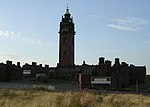
|
| Kelvin Stevenson Memorial Church | 62 Belmont Street, 93 and 99 Garriochmill Road | 15 December 1970 | NS5753367233 | 55°52′38″N 4°16′44″W / 55.877123°N 4.278812°W | John James Stevenson, 1898-1902. Church of Scotland. | 33753 | 
|
| Queens Cross Church and Hall | 870 Garscube Road | 6 July 1966 | NS5797667572 | 55°52′49″N 4°16′19″W / 55.880298°N 4.271915°W | Charles Rennie Mackintosh, 1896-99. | 33764 | 
|
| St Columba of Iona Roman Catholic Church and Presbytery | 74 and 76 Hopehill Road | 6 April 1992 | NS5829567132 | 55°52′35″N 4°16′00″W / 55.876441°N 4.26659°W | 1937, Gillespie, Kidd & Coia. | 33765 | ![St Columba of Iona Roman Catholic Church [de] and Presbytery](http://upload.wikimedia.org/wikipedia/commons/thumb/b/ba/St_Columba%27s_RC_Church_-_geograph.org.uk_-_1177803.jpg/150px-St_Columba%27s_RC_Church_-_geograph.org.uk_-_1177803.jpg)
|
| Former St George’s In the Fields | 485 St George's Road | 6 July 1966 | NS5845866865 | 55°52′27″N 4°15′50″W / 55.874092°N 4.263847°W | 1885-6. H and D Barclay. | 33782 | ![Former St George’s In the Fields [de]](http://upload.wikimedia.org/wikipedia/commons/thumb/9/99/St_George%27s_In_The_Fields_-_geograph.org.uk_-_1177828.jpg/150px-St_George%27s_In_The_Fields_-_geograph.org.uk_-_1177828.jpg)
|
| St Mary's Roman Catholic Church | 99 Abercromby Street | 16 March 1993 | NS6070064541 | 55°51′14″N 4°13′37″W / 55.853881°N 4.226849°W | Goldie and Child, 1841-2. | 33810 | 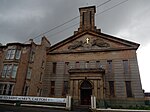
|
| 105–169 Bell Street | 22 March 1977 | NS5976064987 | 55°51′27″N 4°14′31″W / 55.857612°N 4.242083°W | Built 1882. | 33814 | ![105–169 Bell Street [de]](http://upload.wikimedia.org/wikipedia/commons/thumb/8/85/105-169_%28Odd_Nos%29_Bell_Street.jpg/150px-105-169_%28Odd_Nos%29_Bell_Street.jpg)
| |
| Shelter (Bridgeton Umbrella) | Bridgeton Cross | 16 March 1993 | NS6070963997 | 55°50′56″N 4°13′35″W / 55.848999°N 4.226426°W | 1874. | 33818 | ![Shelter (Bridgeton Umbrella [de])](http://upload.wikimedia.org/wikipedia/commons/thumb/9/95/Bridgeton_Cross_-_geograph.org.uk_-_1079913.jpg/150px-Bridgeton_Cross_-_geograph.org.uk_-_1079913.jpg)
|
| Alexander's School | 94 Duke Street | 15 December 1970 | NS6018265190 | 55°51′34″N 4°14′08″W / 55.859557°N 4.235451°W | John Burnet Sr., 1858. Previously used as an annex by St Mungo's Academy. Currently housing small businesses. | 33827 | 
|
| The Doulton Fountain | Glasgow Green | 15 December 1970 | NS6010564314 | 55°51′06″N 4°14′10″W / 55.85167°N 4.236229°W | A E Pearce, 1888. | 33836 | ![The Doulton Fountain [de]](http://upload.wikimedia.org/wikipedia/commons/thumb/b/ba/Doulton_Fountain_-_Glasgow_Green.jpg/150px-Doulton_Fountain_-_Glasgow_Green.jpg)
|
| Nelson Monument | Glasgow Green | 15 December 1970 | NS5982464302 | 55°51′05″N 4°14′27″W / 55.851481°N 4.240707°W | David Hamilton, 1806. | 33837 | 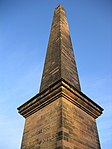
|
| People's Palace | Glasgow Green | 15 December 1970 | NS6002964265 | 55°51′04″N 4°14′15″W / 55.851208°N 4.237416°W | A B MacDonald, City Engineer, 1894-8. | 33838 | 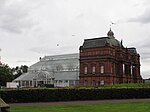
|
| Mercat Building | 15-23 (Odd Nos) London Road and 26 Gallowgate | 15 December 1970 | NS5969064845 | 55°51′23″N 4°14′35″W / 55.856317°N 4.243127°W | A Graham Henderson, 1928-1933. | 33851 | ![Mercat Building [de]](http://upload.wikimedia.org/wikipedia/commons/thumb/2/22/Mercat_Building_-_geograph.org.uk_-_939898.jpg/150px-Mercat_Building_-_geograph.org.uk_-_939898.jpg)
|
| Church of The Sacred Heart | 50-56 (Even Nos) Old Dalmarnock Road | 15 December 1970 | NS6089863678 | 55°50′46″N 4°13′24″W / 55.84619°N 4.223246°W | C J Menart, 1909-10; Presbytery, 1890 by Pugin & Pugin; later alterations by Gillespie, Kidd & Coia, 1953-4 including fresco restoration by William Crosbie. | 33855 | ![Church of The Sacred Heart [de]](http://upload.wikimedia.org/wikipedia/commons/thumb/2/2e/Sacredheartbridgeton.jpg/112px-Sacredheartbridgeton.jpg)
|
| Templeton Carpet Factory | 62 Templeton Street | 6 July 1966 | NS6032564163 | 55°51′01″N 4°13′58″W / 55.850378°N 4.23264°W | William Leiper, 1889. | 33857 | 
|
| Provan Hall | Auchinlea Park, Easterhouse | 15 December 1970 | NS6675566324 | 55°52′18″N 4°07′52″W / 55.871601°N 4.131076°W | House possibly of late medieval origin, retaining a significant amount of early fabric. | 33863 | 
|
| Gartloch Hospital | Gartloch Road | 14 June 1991 | NS6835967134 | 55°52′46″N 4°06′21″W / 55.879315°N 4.105854°W | Thomson and Sandilands, 1889. | 33868 | 
|
| Walmer Crescent | Cessnock | 6 July 1966 | NS5632364465 | 55°51′07″N 4°17′48″W / 55.851914°N 4.296668°W | Alexander Thomson, 1857-62. | 33876 | 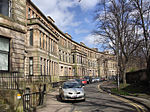
|
| St Andrew’s East Church | 681 Alexandra Parade and 6 Easter Craigs | 15 December 1970 | NS6187565529 | 55°51′47″N 4°12′31″W / 55.863089°N 4.208598°W | James Miller, 1903. | 33879 | ![St Andrew’s East Church [de]](http://upload.wikimedia.org/wikipedia/commons/thumb/5/52/St_Andrews_East_Church.jpg/150px-St_Andrews_East_Church.jpg)
|
| Cast-iron Fountain (Saracen Fountain) | Alexandra Park | 17 June 1992 | NS6190065687 | 55°51′52″N 4°12′30″W / 55.864515°N 4.208279°W | Walter Macfarlane & Co, Saracen Foundry, originally for 1901 Glasgow Empire Exhibition. | 33880 | 
|
| The Necropolis | Cathedral Square | 15 December 1970 | NS6048265549 | 55°51′46″N 4°13′51″W / 55.862868°N 4.230847°W | Opened May 1833. | 33890 | 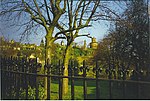
|
| Our Lady of Good Counsel Church | 73 Craigpark | 23 September 1994 | NS6101065499 | 55°51′45″N 4°13′21″W / 55.862571°N 4.222392°W | 1964-5, Gillespie, Kidd & Coia. | 33891 | 
|
| 176 Duke Street, Kirkhaven | 15 December 1970 | NS6052765091 | 55°51′32″N 4°13′48″W / 55.858769°N 4.229893°W | Peddie and Kinnear, 1857-8. | 33899 | ![176 Duke Street, Kirkhaven [de]](http://upload.wikimedia.org/wikipedia/commons/thumb/a/a0/176_Duke_Street%2C_Kirkhaven.jpg/150px-176_Duke_Street%2C_Kirkhaven.jpg)
| |
| St Anne's Church and Presbytery | 17-23 (Odd Nos) Whitevale Street | 27 November 1979 | NS6139464936 | 55°51′27″N 4°12′58″W / 55.857627°N 4.215974°W | Jack Coia of Gillespie, Kidd & Coia, 1931-3. | 33912 | ![St Anne's Church and Presbytery [de]](http://upload.wikimedia.org/wikipedia/commons/thumb/c/c3/St_Anne%27s_Church_and_Presbytery.jpg/150px-St_Anne%27s_Church_and_Presbytery.jpg)
|
| 52–54 Langside Drive | 19 March 1991 | NS5731560342 | 55°48′55″N 4°16′43″W / 55.815193°N 4.278669°W | Late 19th century villa. Listed for its exceptional, near intact Glasgow Style interior. | 33936 |  Upload Photo | |
| Former Waverley Cinema | 18 Moss-Side Road | 17 June 1992 | NS5718062130 | 55°49′52″N 4°16′54″W / 55.831205°N 4.281761°W | Watson, Salmond and Gray, 1922. | 33941 | ![Former Waverley Cinema [de]](http://upload.wikimedia.org/wikipedia/commons/thumb/3/34/Old_Cinema%2C_Moss_Side_Road%2C_Shawlands_-_geograph.org.uk_-_926591.jpg/150px-Old_Cinema%2C_Moss_Side_Road%2C_Shawlands_-_geograph.org.uk_-_926591.jpg)
|
| Holmwood House | 61, 63 Netherlee Road | 17 June 1967 | NS5850559695 | 55°48′35″N 4°15′34″W / 55.809734°N 4.259358°W | Alexander Thomson, 1857-59. | 33944 | 
|
| Pollokshaws Burgh Hall | 2025 Pollokshaws Road | 15 December 1970 | NS5612561514 | 55°49′31″N 4°17′54″W / 55.825362°N 4.298264°W | Robert Rowand Anderson, 1895-8. | 33953 | 
|
| Anniesland Court | 833-861 (Odd Nos) Crow Road, Anniesland | 2 April 1996 | NS5467368865 | 55°53′27″N 4°19′31″W / 55.89092°N 4.325361°W | Jack Holmes and Partners, 1966-8. | 43034 | 
|
| St Andrew's East Church Hall | 685 Alexandra Parade | 15 December 1970 | NS6189565518 | 55°51′47″N 4°12′30″W / 55.862996°N 4.208273°W | James Salmon Junior and J Gaff Gillespie, 1899. | 48569 | 
|
| Scottish Ambulance Service station and St Andrew’s House, St Andrew's Ambulance Association | 30 Maitland Street and 54 Milton Street | 7 February 2005 | NS5888166138 | 55°52′04″N 4°15′24″W / 55.867689°N 4.256713°W | Begun Skinner, Bailey & Lubetkin, followed by Bailey and Robb, circa 1966-70. | 50073 | ![Scottish Ambulance Service station and St Andrew’s House [de], St Andrew's Ambulance Association](http://upload.wikimedia.org/wikipedia/commons/thumb/e/e9/St_Andrew%27s_House_DSCN1882.jpg/150px-St_Andrew%27s_House_DSCN1882.jpg)
|
| Burrell Collection | 2060 Pollokshaws Road, Pollok Country Park | 23 January 2013 | NS5548662138 | 55°49′51″N 4°18′27″W / 55.830833°N 4.3075°W | Barry Gasson Architects (firm), 1971-1983. | 52002 | 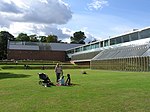
|
See also
[edit]Notes
[edit]- ^ Sometimes known as OSGB36, the grid reference (where provided) is based on the British national grid reference system used by the Ordnance Survey.
• "Guide to National Grid". Ordnance Survey. Retrieved 12 December 2007.
• "Get-a-map". Ordnance Survey. Retrieved 17 December 2007. - ^ Historic Environment Scotland assign a unique alphanumeric identifier to each designated site in Scotland, for listed buildings this always begins with "LB", for example "LB12345".
References
[edit]- ^ Guide to the Protection of Scotland's Listed Buildings (PDF). Historic Scotland. 2009. p. 4. ISBN 978-1-84917-013-0. Retrieved 5 May 2010.
- ^ "What is Listing?". Historic Scotland. Retrieved 5 May 2010.
- ^ a b Scottish Historic Environment Policy (PDF). Historic Scotland. October 2008. pp. 24–25. ISBN 978-1-84917-002-4. Retrieved 5 May 2010.
- ^ Guide to the Protection of Scotland's Listed Buildings, p. 17.
- ^ Dan Cruickshank, A Guide to the Georgian Buildings of Britain & Ireland, George Weidenfeld and Nicolson Ltd, 1985, pp.210-211.
- ^ A. Gomme, D. Walker, Architecture of Glasgow, Lund Humphries, 1968, p.92
- ^ F Wordsall, The City That Disappeared: Glasgow's Demolished Architecture, Richard Drew, 1981, p.11
- ^ Glasgow Central Conservation Area Appraisal, City Design Group, Development & Regeneration Services, Glasgow City Council, 2012, p.12
- ^ Glasgow Central Conservation Area Appraisal, City Design Group, Development & Regeneration Services, Glasgow City Council, 2012, p.23
- ^ See Gomme, Walker, 1968, pp.153-167
- ^ Williamson et al., 1990, p.11
- ^ F. Worsdall, Victorian City, Richard Drew, 1982, p.86
- ^ A. Gomme, D. Walker, Architecture of Glasgow, Lund Humphries, 1968, pp.19-39
- ^ George Fairfull Smith, "Lanarkshire House, Glasgow: The Evolution and Regeneration of a 'Merchant City' Landmark." Architectural History 42 (1999): pp.293-306.
- ^ A.M. Doak, D. Walker, Glasgow at a Glance : an Architectural Handbook, Collins, 1965, p.24, n.25
- ^ Doak, Walker, 1965, n.10
- ^ See N. Pevsner, Pioneers of Modern Design, Penguin, 1960, p.122.
- ^ John R. Hume, Industrial Archaeology of Glasgow, Blackie & Son, 1974, p.122
Bibliography
[edit]- William A. Brogden (ed), The Neo-classical Town: Scottish Contributions to Urban Design Since 1750, Rutland Press, 1996
- A.M. Doak, D. Walker, Glasgow at a Glance: an Architectural Handbook, Collins, 1965
- Glasgow Central Conservation Area Appraisal, City Design Group, Development & Regeneration Services, Glasgow City Council, 2012, (PDF)
- A. Gomme, D. Walker, Architecture of Glasgow, Lund Humphries, 1968
- Henry-Russell Hitchcock, Early Victorian Architecture in Britain, Yale, 1954
- John R. Hume, Industrial Archaeology of Glasgow, Blackie & Son, 1974
- Deborah Mays, The Architecture of Scottish Cities, Tuckwell Press, 2001
- Ronald McFadzean, Life and Work of Alexander Thomson, Routledge, 1979
- Charles McKean, Central Glasgow - an Illustrated Architectural Guide, Mainstream Publishing, 1989
- Ray McKenzie, Public Sculpture of Glasgow, Liverpool University Press, 2002
- Peter Reed, Glasgow: The Forming of The City, Edinburgh University Press, 1999
- Sam Small, Greater Glasgow: An Illustrated Architectural Guide, The Royal Incorporation of Architects in Scotland, 2008.
- Robin Ward, Exploring Glasgow: The Architectural Guide, Birlinn, 2017
- Elizabeth Williamson, Anne Riches, Malcolm Higgs, Buildings of Scotland: Glasgow, Yale, 1990
- F. Worsdall, Victorian City, Richard Drew, 1982
- Frank Worsdall, The Tenement: A Way of Life, Chambers, 1979

